Morocco is a study in contrasts. Roosters crowing outside stunning five-star hotels. Nomadic Berber tents outfitted with solar panels. Swank rooftop bars awash in mint tea…instead of booze. The ultimate Morocco itinerary includes these experiences and so much more!
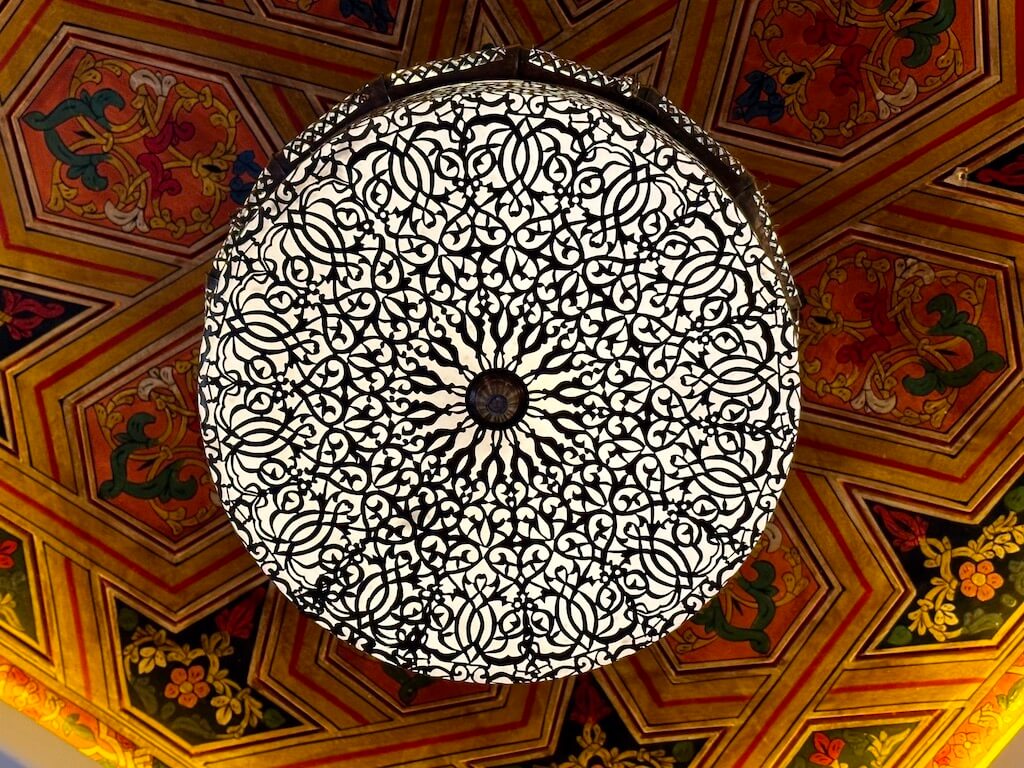
Contents
- Morocco Itinerary: 10 Days
- Morocco Itinerary 14 Days
- Your Morocco itinerary is a wrap.
- Morocco FAQ
- 1. How many days do you need in Morocco?
- 2. Is Casablanca better than Marrakech?
- 3. What are the best months to visit Morocco?
- 4. Is Morocco an expensive vacation?
- 5. What language is spoken in Morocco?
- 6. What should I wear when visiting Morocco?
- 7. How should I get around Morocco?
- 8. What are some must-visit attractions in Morocco?
- 9. What is the cuisine like in Morocco?
- 10. What is the etiquette for haggling in Moroccan markets?
Morocco Itinerary: 10 Days
Welcome to Morocco, a land of vibrant colors, mesmerizing landscapes, and rich cultural heritage.
This 10-day itinerary is designed to take you on a journey through the most captivating parts of this North African country, from the bustling streets of Marrakech—sooo many scooters—to the tranquil beauty of the world-famous Sahara desert.
Along the way, you’ll indulge in local delicacies, haggle in souks, and immerse yourself in the unique culture of this land.
With 10 days in Morocco, you’ll want to focus on the imperial cities of Rabat, Fez, and Marrakesh plus seeing the Sahara Desert.
It’s a lengthy drive to the Sahara in the south of Morocco (eight-plus hours from Marrakesh), but don’t worry!
You’ll enjoy lots of scenic stops to enjoy Morocco’s Little Switzerland, Atlas Mountains, and even Roman ruins!

Day 1: Rabat
Most international travelers arrive in either Rabat or Casablanca…sometimes Marrakesh.
All three of these cities should be on your itinerary and aren’t far apart so it’s easy to adjust your itinerary accordingly. Just look for the best airfare and head there!
Stay in a Riad
If you’re arriving in Rabat, the capital of Morocco, as we did, head to your riad and get settled in.
You’re likely to experience your first “oh-my-gosh-I’m-in-Morocco!” moment as Moroccan riads are otherworldly beautiful.
Colorful zellij tile and dramatic Moorish arches abound! Riads are former mansions turned into hotels and offer a distinct experience. From the street, you’ll likely find an unassuming door.
But that door typically opens into a beautiful courtyard, with a pool or fountain surrounded by private bedrooms. Winding staircases and mood lighting from beautiful lanterns complete the effect.

Riads are designed to maximize privacy from the outside world and provide a family gathering place inside.
In Morocco, accommodation is inexpensive (by US standards) so my advice is to book five-star riads as we did. Recommendations below!
A bonus is that many riads include an onsight restaurant and almost always include a beautiful breakfast.
Quality varies for evening meals but it’s a convenient option after a full day of sightseeing.
Visit Kasbah of the Udayas
Spend the rest of the day exploring the city, starting with the Kasbah of the Udayas, a UNESCO World Heritage site that was built in the 12th century.
Located on a hill at the mouth of a river, just across from the modern town of Salé, this Kasbah (or fortress) has been keeping watch for intruders here since the 10th century!
Don’t miss the Great Gate of the Kasbah—”Bab Oudaya”—while you’re here. it’s considered one of the most beautiful gates showcasing Moroccan architecture.
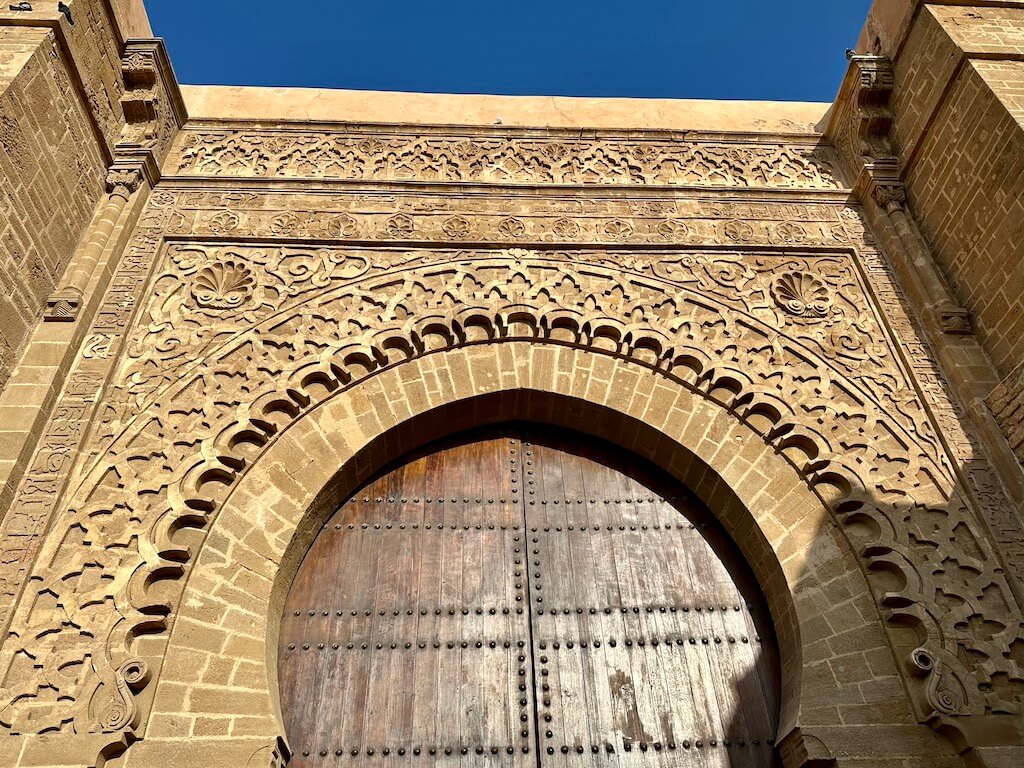
See Hassan Tower and the Mausoleum of Mohammed V
From there, head to the Hassan Tower, a 12th-century minaret that was never completed, and the nearby Mausoleum of Mohammed V.
It contains the tombs of Moroccan King Mohammed V and his two sons.
You’ll also likely note the dramatic and modern Mohammed VI Tower—a bright white obelisk—against the Rabat skyline. While it’s not yet finished, it’s on track to be the tallest tower in Africa!
Complete your evening with a great meal. You’ll want to taste your first tagine!
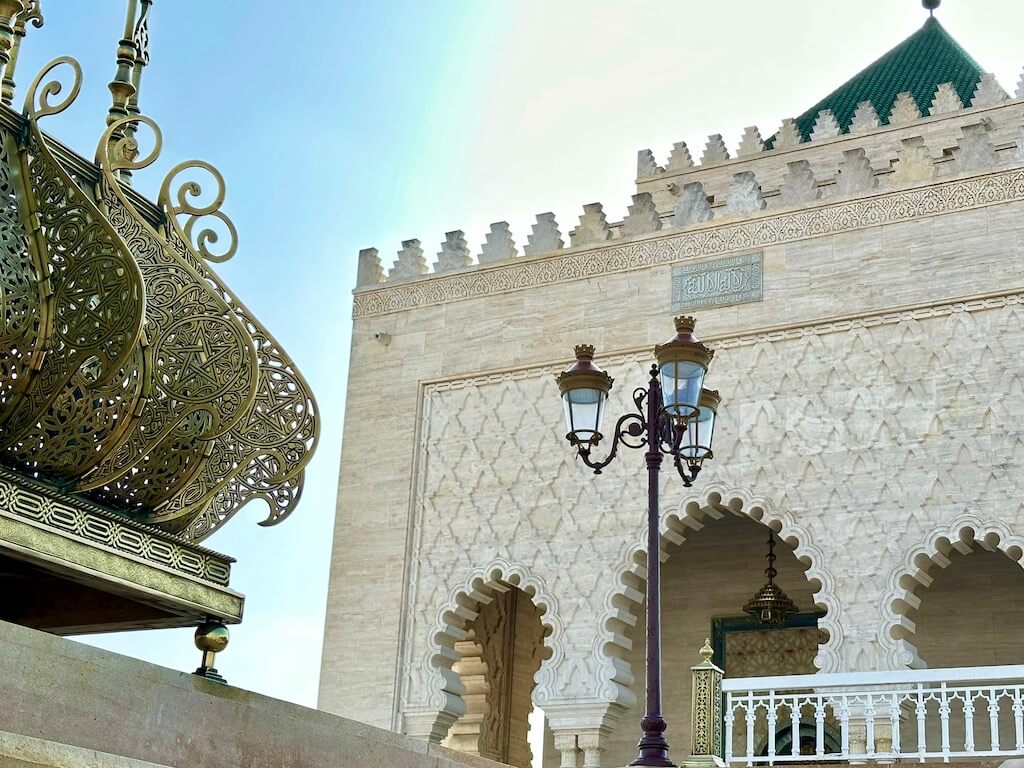
Named after the earthenware pot in which it’s cooked, Moroccan tagine is an absolutely delicious slow-cooked stew, traditionally cooked over a charcoal fire.
It includes couscous, vegetables and chicken, beef, or fish. (Also available as a vegetarian version.)
One of the best tagines we had during our two weeks in Morocco was on our very first evening at Dar Naji Rabat. Try the freshly squeezed fruit juices, too!
Where to stay in Rabat: Riad ZYO Rabat made an amazing first impression on our first night in Morocco! This is a small and cozy riad conveniently located in the medina with a fabulous breakfast.
Check price and availability at Riad ZYO Rabat here.
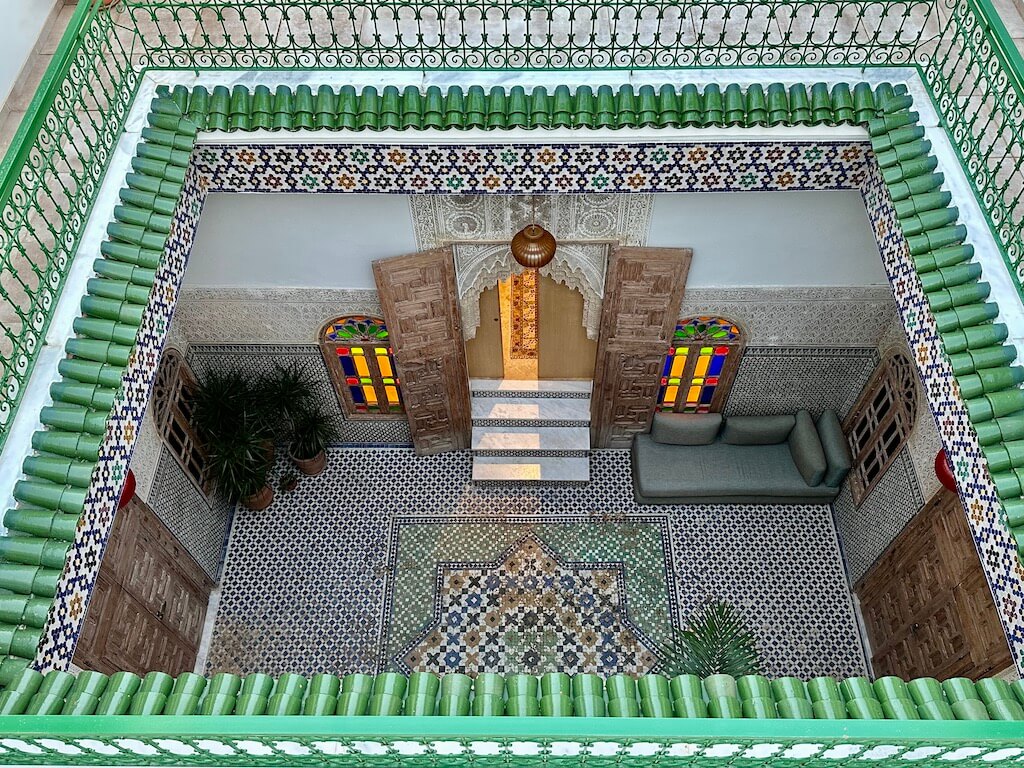
Hire a private tour guide and driver.
As an independent traveler, this was the first time I’ve ever hired a tour guide and driver for a private multi-day tour. It was my first time in Africa, first time in a Muslim country, and I had my elderly mom in tow.
Said Hatouchi at Morocco Daily Tours is amazing. He’s knowledgeable, honest, open, affordable, and 100 percent committed to making your vacation just the way you want it to be. He and his driver Zaid felt like family by the end of our two-week tour. You can read Trip Advisor reviews here.
I’d recommend his custom private tours for just about anyone: couples, solo female travelers, or multi-generational trips with families.
As an Explore Now or Never reader, you can save 5 percent when you book either a day trip or a multi-day tour using code EXPLORE NOW.
Even better, I’ve arranged for an additional 5 percent of your tour price to be donated to an international not-for-profit organization that supports Moroccan women.
More on that soon but it’s a win-win-win and you can book now using the discount code above!
Side note: I paid full price for my tour. I don’t accept sponsored travel. I also make no commission on your booking with this company. I honestly just want to recommend an A+ experience to you and support a great guide.
Day 2: Chefchaeouen
it’s about a four-hour drive north from Rabat into the Rif Mountains where you’ll arrive at Chefchaouen, known as “The Blue City.”
Why is it called The Blue City? Because the entire town is painted in shades of blue!
There are different versions of the story behind why this is. One says that Sephardic Jews brought this tradition of painting buildings blue like the sky.
Another says that blue represents the peace and harmony of Moors and Jews living together here. Many Jews immigrated to Chefchaeouen during WWII to escape Hitler’s Nazis.
In any case, this tiny town is a popular tourist destination for its relaxed atmosphere and scenic beauty.
Spend the day wandering the streets, browsing the markets, and enjoying the local cuisine.
Chefchaeouen can get crowded with day trippers so spending the night here gives you plenty of time to enjoy the morning all to yourself.
Where to stay in Chefchaeouen: Stay at Dar Echchaouen. This is a stunning property on a hill with a beautiful pool, panoramic views of the Blue City, and truly lovely rooms. The on-site restaurant was adequate but not amazing so I’d book dinner elsewhere next time but I’d stay here again in a heartbeat!
Check price and availability at Dar Echchaouen here.
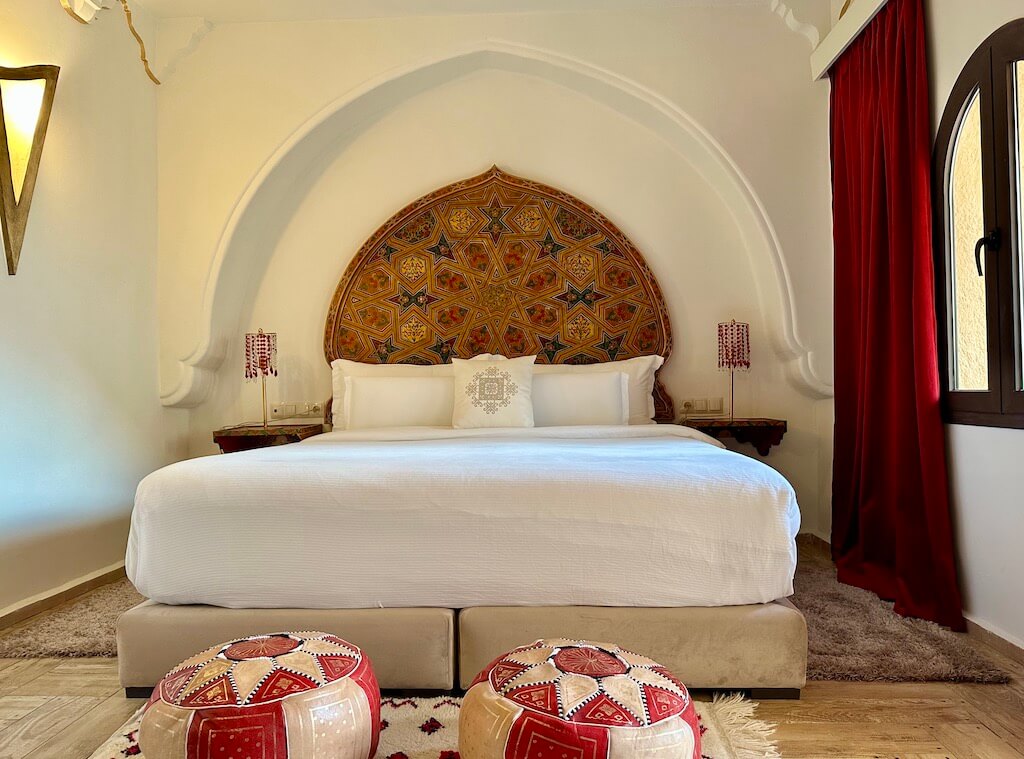
Day 3: To Fez via Volubilis & Meknes
It’s about a 3 1/2 hour drive from Chefchaouen south to your next recommended stop, Fez. But plan to spend most of the day en route as there are some spectacular sites here!
You’ll travel through some bucolic farmlands where olives and grapes are grown until you reach Volubilis, a 2,0000-year-old UNESCO site of ancient Roman ruins.
The ruins you see here are the remains of the Roman Empire’s most southern outpost.
There’s a lot to see here between the remnants of Roman villas, public houses, arches, and intact tile mosaic floors everywhere.
One of the best things about Volubilis is that it’s a bit off the beaten track. It was just us, our guide, and a handful of people taking it all in here.
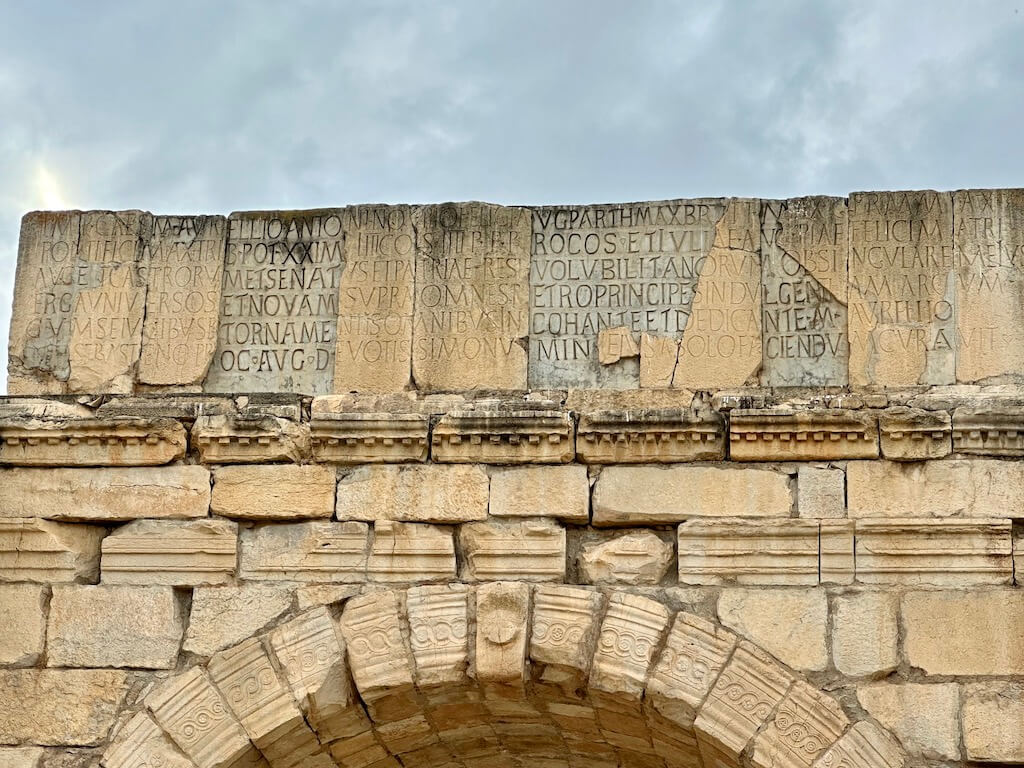
You may also want to stop in nearby Meknes before ending your day in Fez. It’s another imperial city in Morocco that is well known for its Moorish architecture.
While you’re here, see the beautiful Bab-el-Mansour, an 18th-century gate, one of the largest and most impressive in all of Morocco!
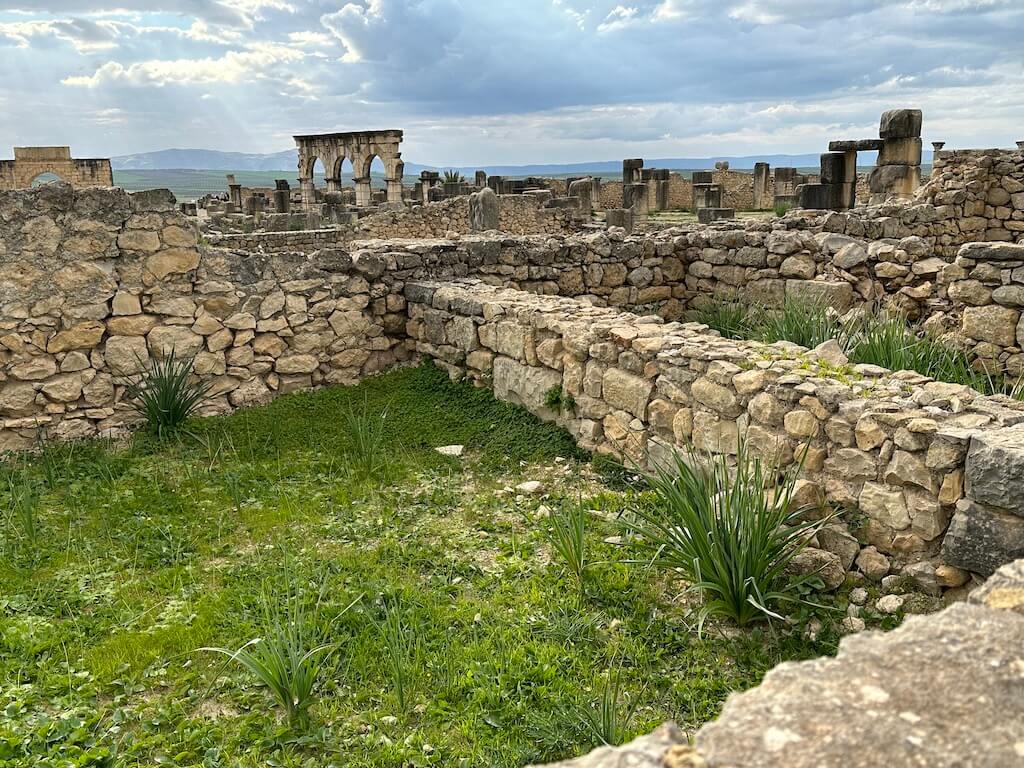
Where to stay in Fez: You’ll feel like a celebrity when you roll up to the five-star Palais Faraj hotel. It’s a former Arab-Moorish palace!
Your room is a spacious full suite covered in Zellij tiles. Plus, your stay comes with the most incredible breakfast buffet. There’s also a hamam onsite. I’d skip the fancy onsite restaurant in future (overpriced) but try the rooftop cafe instead.
Check price and availability at Palais Faraj here.
Read more on Morocco travel:
• 21 Places to Visit in Morocco
• Advice on Traveling to Morocco
Day 4: Fez
Welcome to Fez! This amazing imperial city is home to the world’s oldest university and its medina is a UNESCO World Heritage site. It deserves at least a full day in your itinerary.
Fez, also spelled “Fes”, is one of Morocco’s most fascinating cities and a must-visit destination for anyone interested in history, culture, and architecture.
As you tour the city, you might notice a logo of a big yellow smiley face wearing a bright red fez. The slogan says, “Smile! You are in Fes.”
It’s a bid by the tourism board to counter the reputation of Fez as a serious place haha.
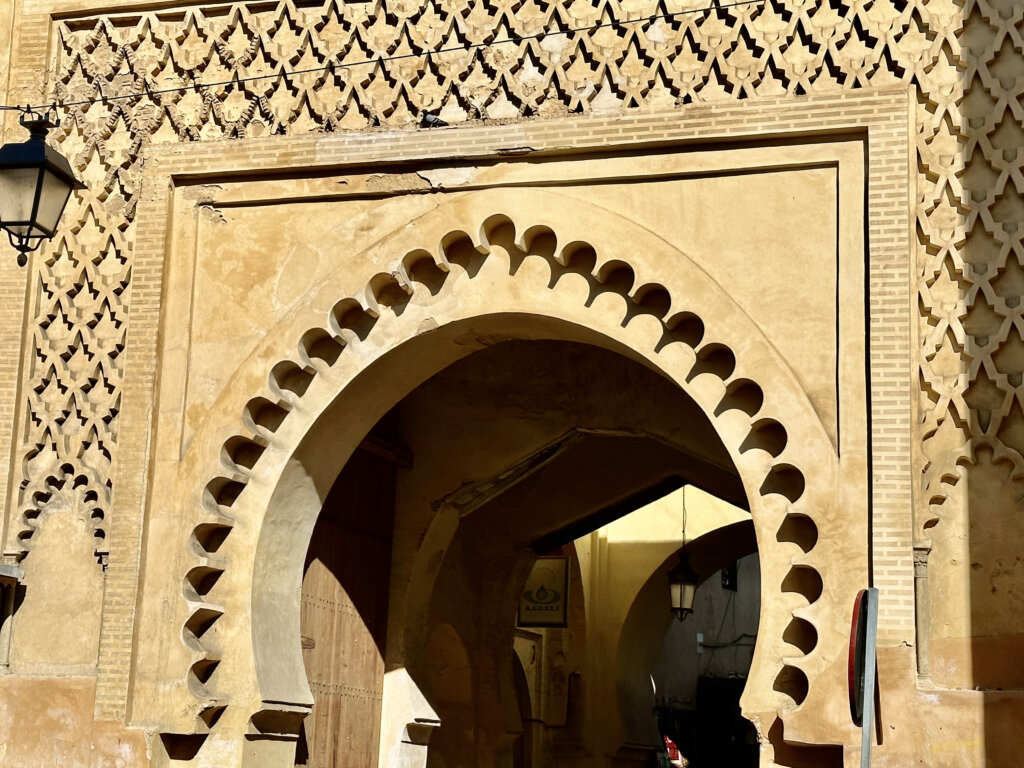
As one of the country’s oldest and largest cities, Fez is a living museum that boasts an impressive array of medieval architecture, including the world-famous University of Al Karaouine, which dates back to the 9th century and is still operating today!
There are three distinct areas in Fez: Fez el Bali (the oldest part of the city with 9,000 narrow streets and alleys in the medina), Fez-Jdid, home to the Jewish quarter near the palace, and Ville Nouvelle, the newest part of Fez, created during the French revolution.
You can’t leave Fez though without a first-hand appreciation of the incredible artisans here.
We really enjoyed our visit to a pottery shop to see ceramic tagines being made as well as tile artisans hammering Zellij tiles in the traditional way.
Finish the day with a visit to the leather tanneries—Chouara Tannery is the best known—where you can see the traditional process of leather-making.
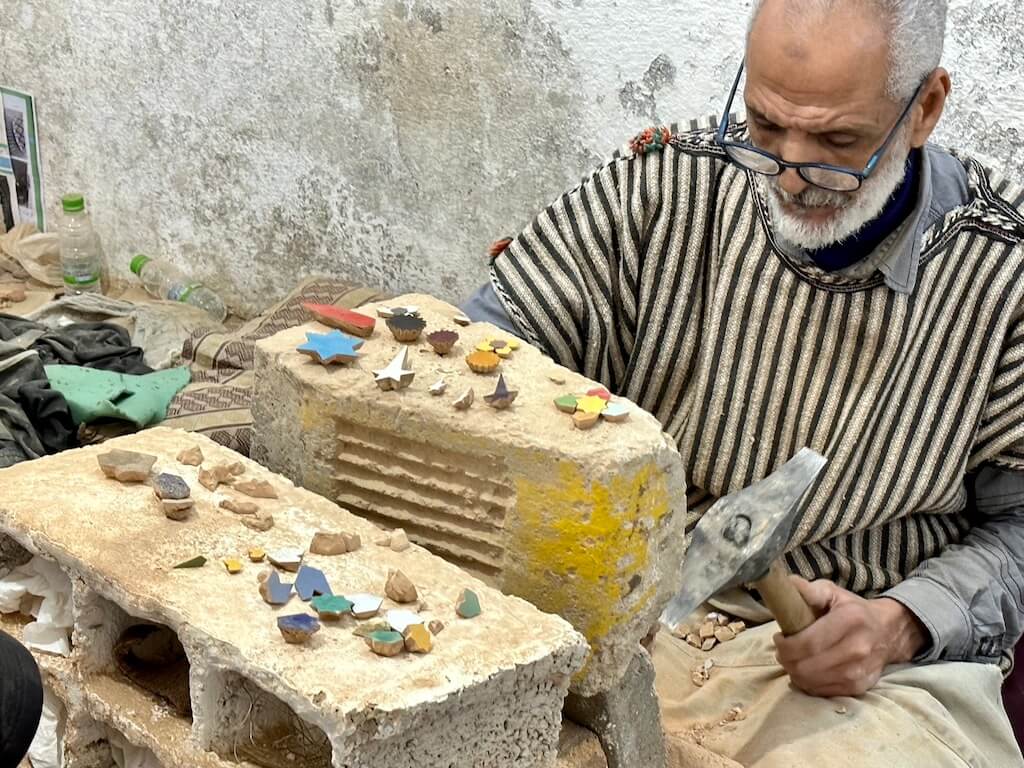
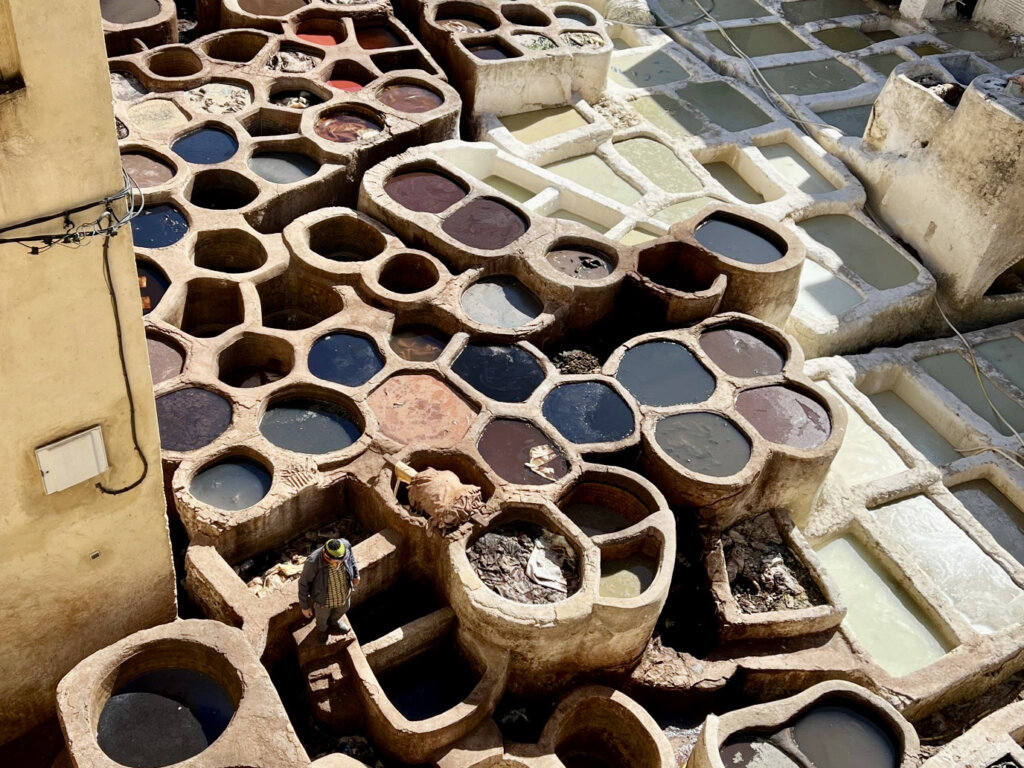
Day 5: To Merzouga
After breakfast, depart Fez and begin the drive to Merzouga, a small village in the Sahara Desert.
It’s a long journey at more than seven hours on the road but definitely worth doing!
Along the way, a great place for a stop is Ifrane in the middle Atlas Mountains. It’s leafy and green (snowy when we were there in February) and is known as Morocco’s Little Switzerland.
Plus, there are wild monkeys that live here in a cedar forest! If you’re fortunate enough to see them, please remember not to feed wildlife and enjoy them from afar.
Eventually, you’ll cross the Ziz Valley and the famous tunnel. The panoramic views of the ochre-colored cliffs are really something to see.
This area is home to lots of date palms, figs, and olives. You’ll see dozens and dozens of Aoufous palm trees framing the views here.
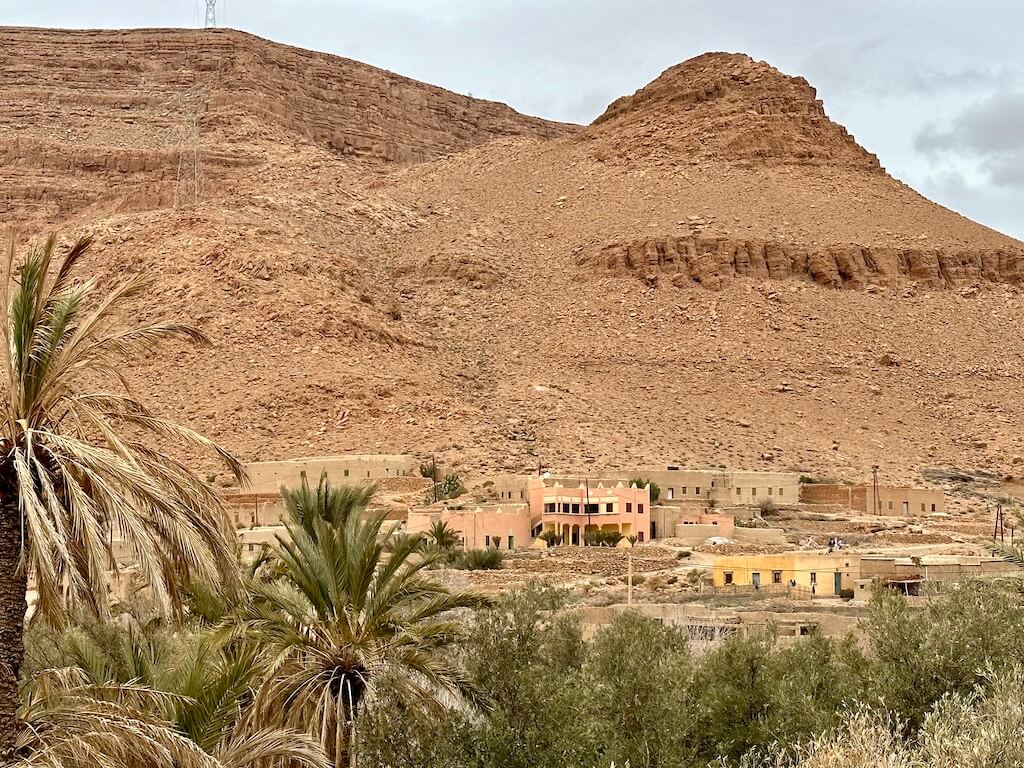
Arrive in Merzouga for a 90-minute camel ride into the amazing Sahara Desert. This was a bucket list experience for us.
There’s really nothing like watching golden sand dunes undulate at sunset as far as your eye can see.
You can stop along the way to buy a scarf—you’ll want one to protect you from the sand, heat, and wind—and have someone show you how to tie it to cover your face and head.
It’s known as a “tagelmust” when tied this way.
Unfortunately for us though, our caravan included two American frat boys who were on their cell phones the entire time to let everyone back home know that “Duuuude! I’m on a camel in the Sahara Desert!”
I’m glad that nomadic Berbers here have access to a strong cell signal here but oof! Most ridiculous and inconsiderate tourists ever.
Please don’t be that person. Sometimes it’s really just about really being present and taking it all in. This is one of those moments!
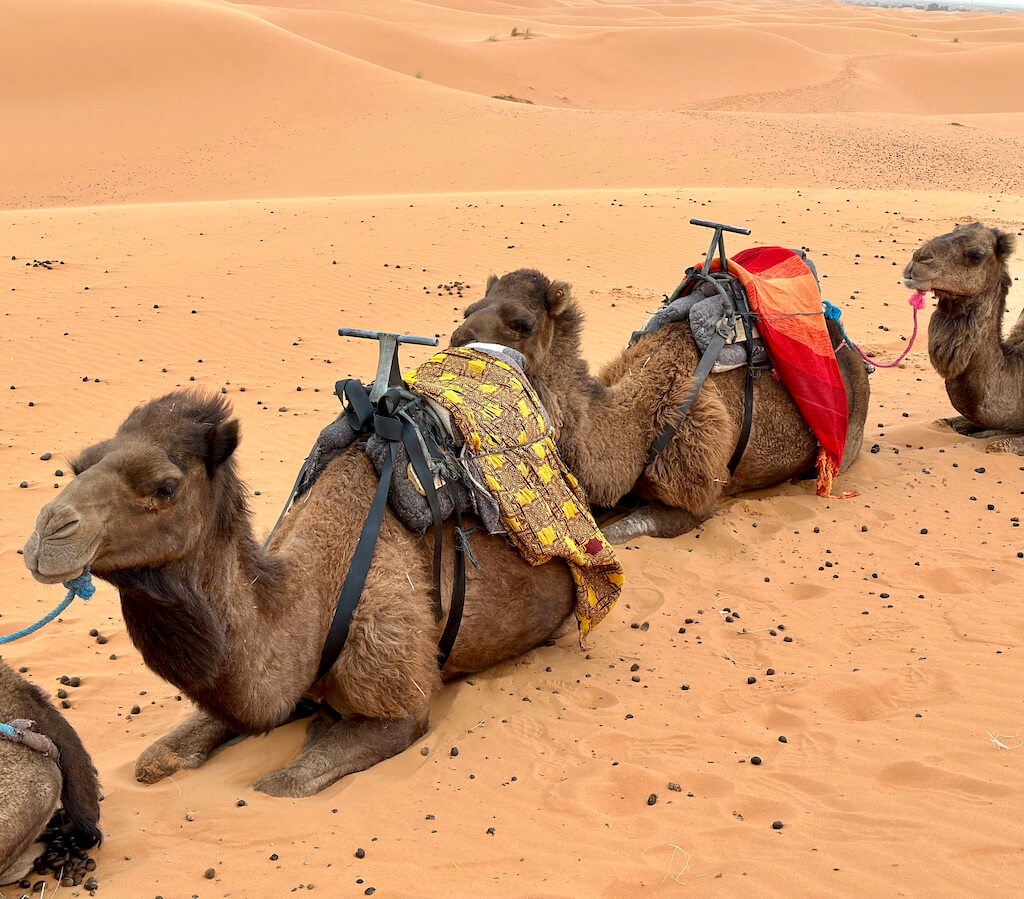
Where to stay in the Sahara Desert: Stay at Desert Lover’s Luxury Camp. Your room includes a private bathroom and shower, comfy beds, wifi, and two hot meals daily!
Check price and availability at Desert Lover’s Luxury Camp here.
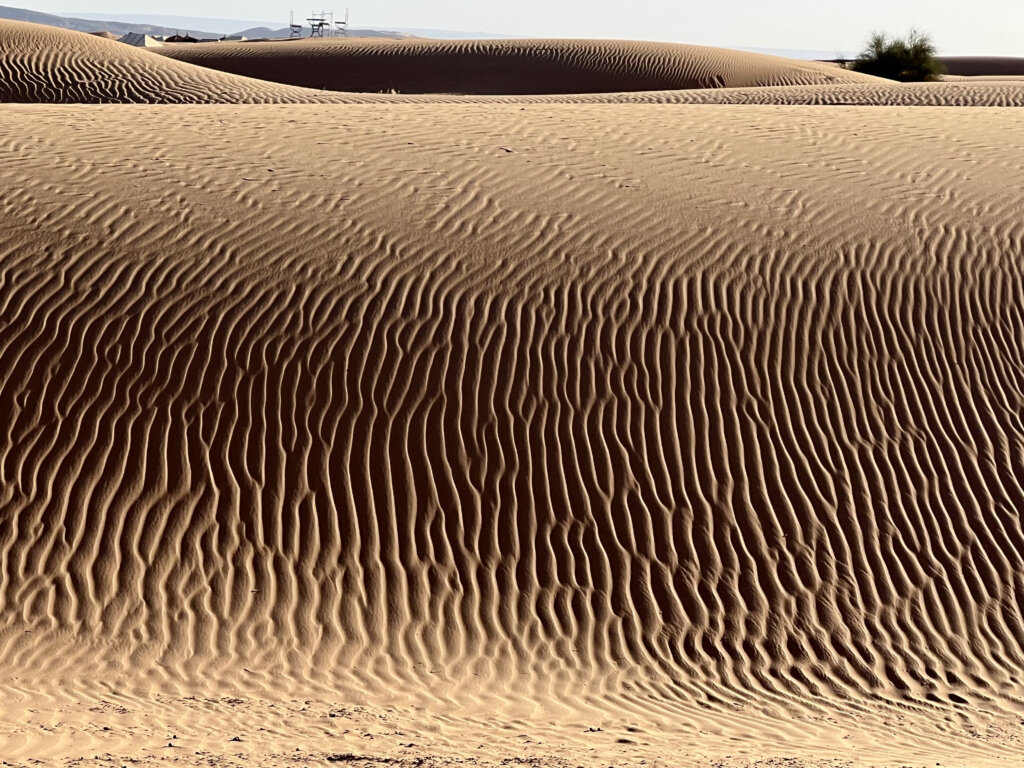
Day 6: Sahara Desert
Welcome to Erg Chebbi (“sea of dunes”) in the otherworldly Sahara Desert.
Be aware that it is really rather cold in winter!
While the tent camps do have solar panels for the tent camps, they need to use the available energy sparingly and so do not heat the tents. You may or may not have a hot shower.
Also, as you might expect, it’s super warm here in summer.
I was shocked to hear that many people head here in 120 Farehnehit heat! They sleep under the stars but also there can be sand storms during the day. “It’s hell on earth,” one local told me.
We visited Morocco in February but if I were to plan a next trip, I’d pick spring or fall for this reason.
Whatever you do, rise early for the magical sunrise here. Then spend the day exploring the desert. Sandboarding and ATVing are popular activities here.
We really enjoyed our visit to the tiny village of Khamlia. This is home to the Gnawa people, Black Africans from sub-Saharan countries like Mali, Niger, and Sudan.
Their ancestors were moved here to the Sahara as slaves and sang to soothe themselves amidst the chanting and clanking of their chains.
Today, their descendants have preserved this traditional music and art form and keep it alive with performances for visitors here in the village. It was such a powerful experience!
This area is a great place to also taste “Medfouna” or Berber pizza. It’s actually more of a flatbread that is stuffed with meat, spices, and onions and then cooked in a mud oven. It gets its name from its round pizza shape!
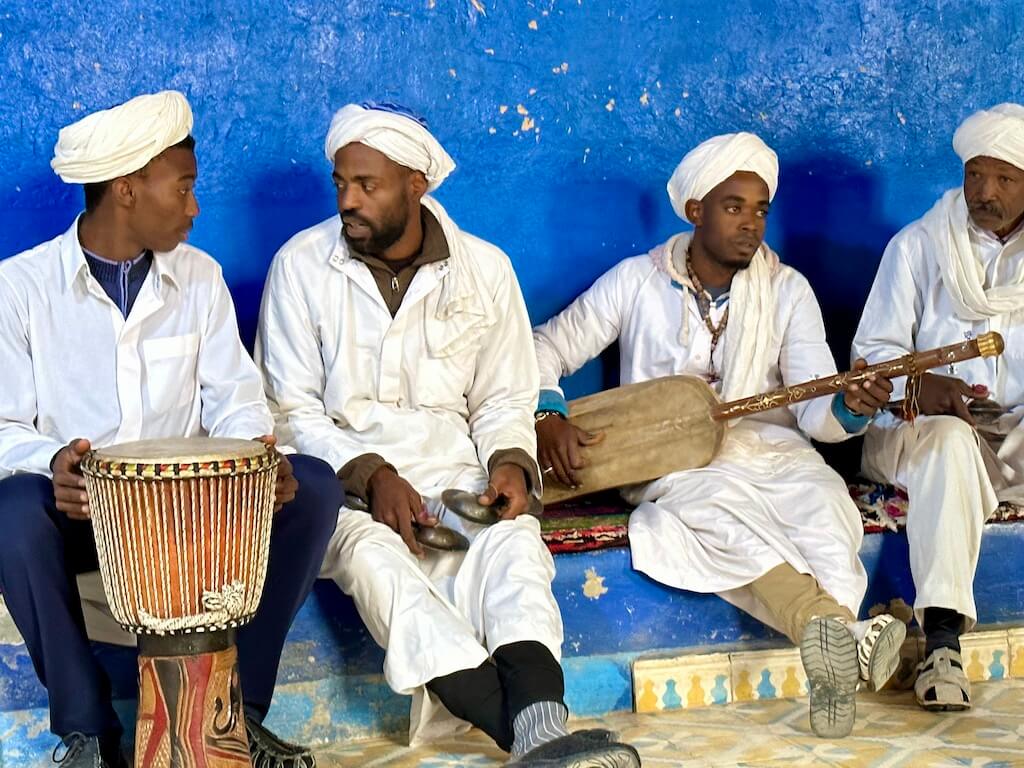
While you’re exploring Erg Chebbi today, be sure to visit a nomadic Berber or “Amazigh” family.
These families speak Tamazight rather than Arabic or French and move in groups every few months in search of food for their goats.
Many of them earn a little extra money by serving mint tea and bread to visiting tourists in their tents.
It’s a hard life they live so enjoy this cultural experience and know that your tourism dollar is going directly to a family that needs it.
In the evening, return to your camp and enjoy a traditional Moroccan dinner under the stars.

Day 7: To Boumalne Dades
After breakfast, depart Merzouga and begin the journey west to cosmopolitan Marrakech.
Since this is another long drive (8.5 hours), I recommend you overnight as we did in Boumaln Dades in the scenic Dades Valley.
Rissani makes a great stop to visit its famous souk. We purchased all kinds of spices here.
Erfoud—the capital of fossils and marble—is also highly impressive. Definitely worth dipping into one of the shops for a fossil souvenir.
And these aren’t any old fossils. You’ll see incredible furniture—think unique tables and custom fossilized marble kitchen counters—that is definitely worth seeing, even if you’re not buying.

The biggest highlight of this day for us was our visit to Todra Gorge, a natural oasis in the High Atlas Mountains.
Tall narrow limestone canyons—with a river carving a path through them—reminded me so much of some of Utah’s slot canyons.
Where to stay in Dades: Stay at Dades Xaluca Hotel. While the rooms were smaller here than other places we stayed, the hotel had a wonderful view and our stay included the most extensive buffet breakfast and dinner we had during our two weeks in Morocco!
Check availability at Dades Xaluca Hotel here.
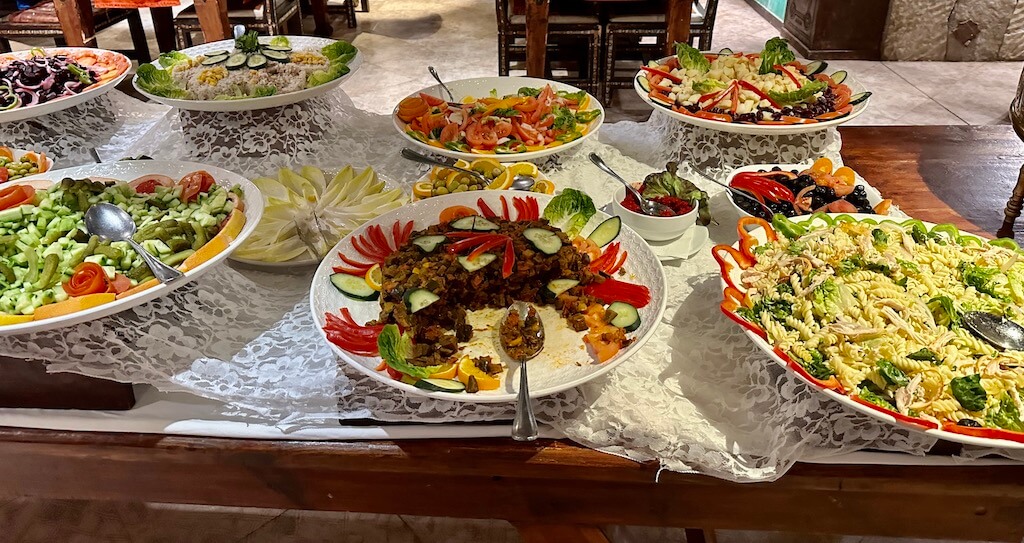
Day 8: To Marrakech via Ait Ben Haddou
Today, you’ll drive the Road of a Thousand Kasbahs, a spectacular road through palm groves and beautiful desert landscapes.
First stop: The city of Ouarzazate, “Hollywood of Morocco.”
If you’re a film lover, stop here for a tour of the Atlas Studio. Dozens and dozens of high-profile movies have been filmed here since the 1950s, including Game of Thrones in 2012 (for season 3).
Be sure to visit the Kasbah of Taourirt, a 19th-century fortress that was once home to the Glaoui family.
From there, continue on to Ait Ben Haddou, a UNESCO World Heritage site that is home to some of the most well-preserved kasbahs in Morocco.
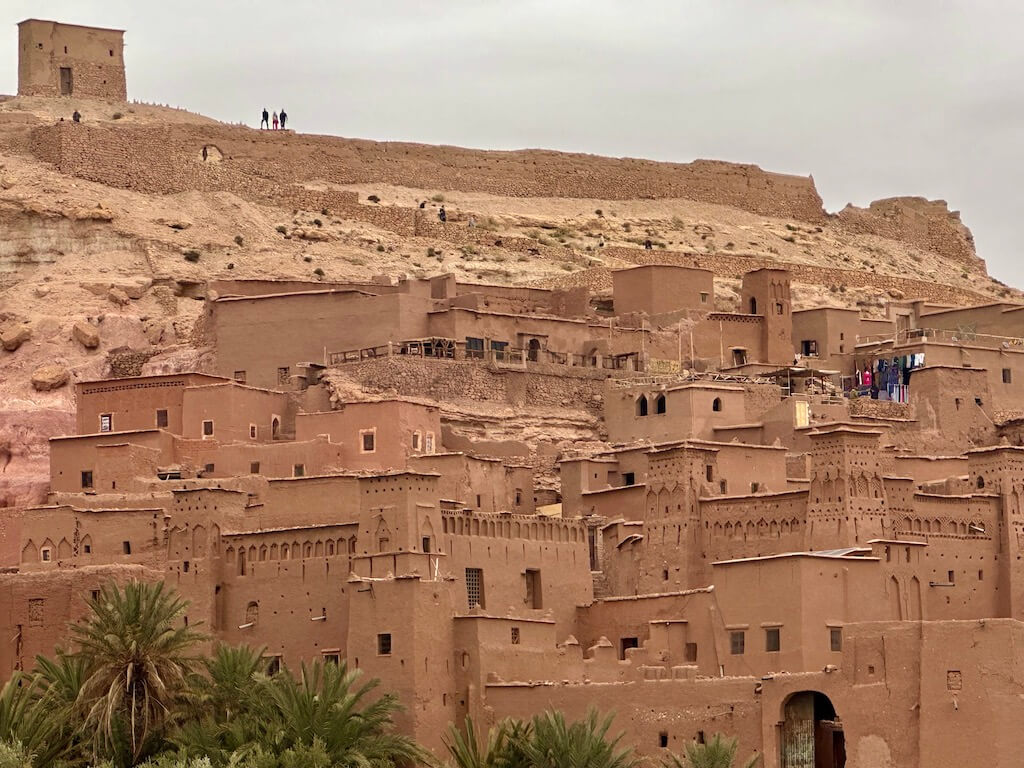
This 11th-century fortified village is an impressive sight with its red mud plaster buildings.
You’ll definitely want to wander the narrow alleyways here and think about the traders that stopped on this important trans-Saharan caravan route to trade their spices and gold all those years ago.
Finish the day with a drive through the stunning Tizi n’Tichka Pass, which offers panoramic views of the Atlas Mountains.
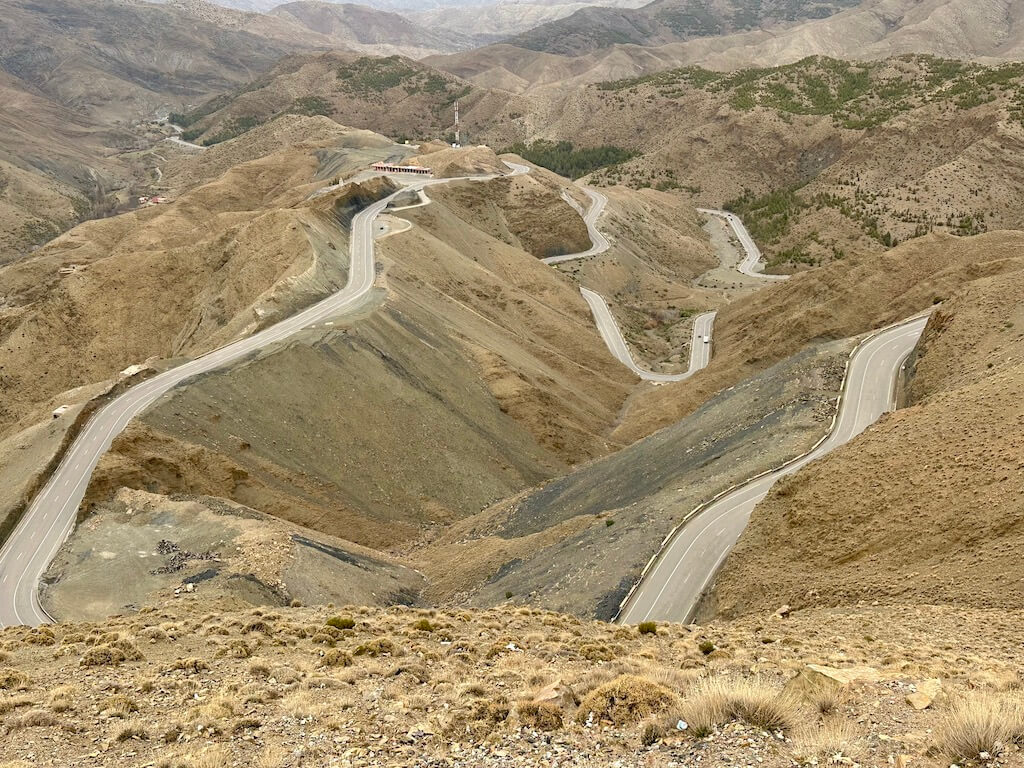
Where to stay in Marrakech: Palais Sebban was our favorite riad in Morocco! It had a very boutique feel with absolutely stunning rooms and public spaces. It also had the best onsite restaurant of anywhere we stayed. Highly recommended.
Check price and availability at Palais Sebban here.
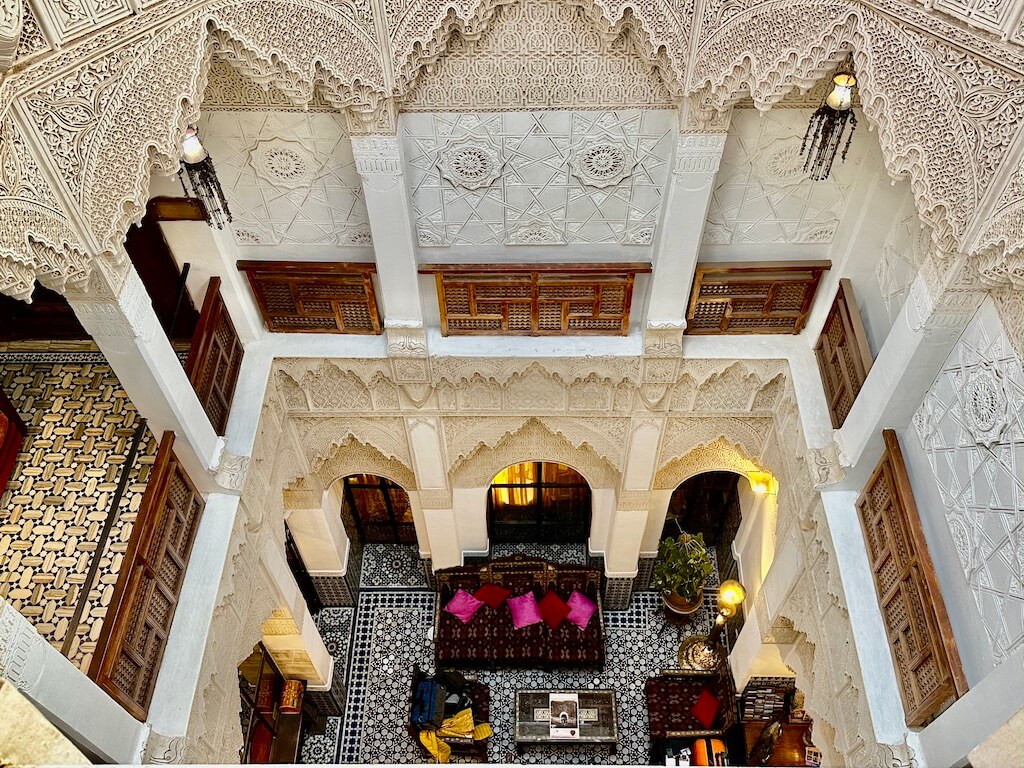
Day 9: Marrakech
Spend today exploring incredible Marrakech, “the red city”. Why is it known as the red city? This city is enclosed by 12 miles of red walls.
If you have just one day in Marrakech, it’s going to be a busy one.
And if you have more than 10 days in Morocco, Marrakech is a great place to base for multiple days to add in a few day trips. (See “Morocco itinerary: 14 days” below for suggestions.)
See Koutubia Mosque
The Koutoubia Mosque is one of the most famous landmarks of the city and is known for its impressive minaret, which stands 252 feet high and is visible from miles away.
The mosque was constructed in the 12th century during the reign of the Almohad Caliphate, and it has since been renovated and restored multiple times.
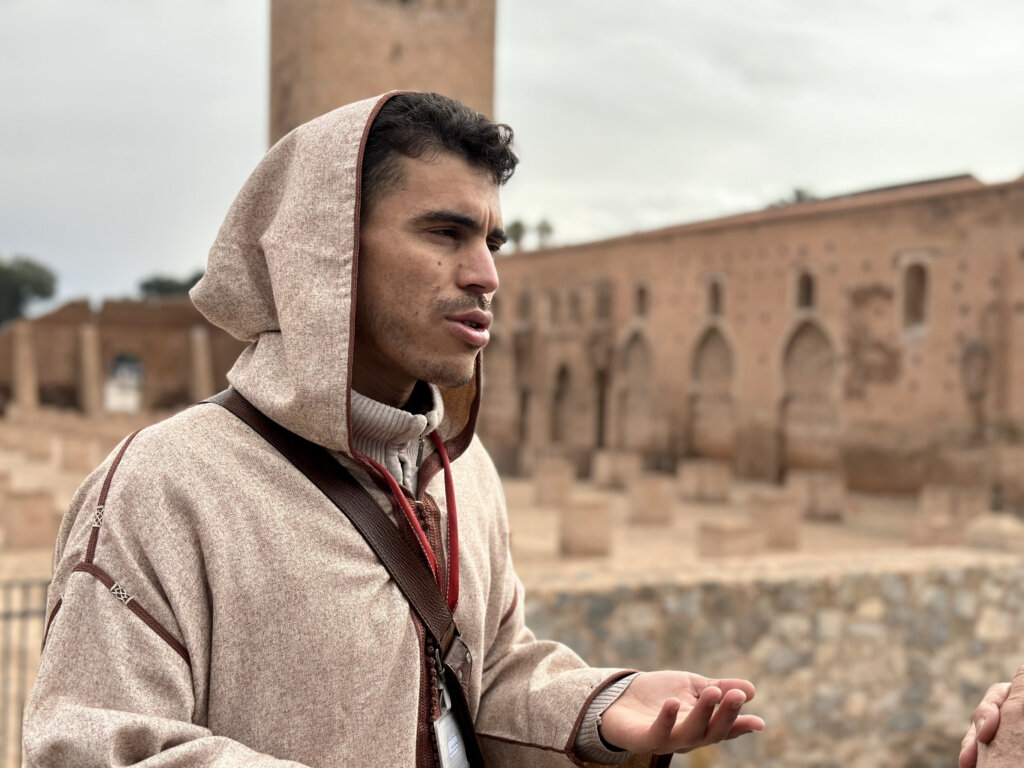
Explore the World-Famous Medina
The medina in Marrakech is a UNESCO World Heritage site. In addition to Koutubia Mosque, Marrakech’s medina includes Bahaia Palace (more below) the Saadian Tombs, which date back to the 16th century, and one of the best souks in Morocco.
This is the place to haggle for spices, olives, beautiful lanterns, rugs, and thousands of other items!
Remember that bargaining in Morocco is an art form and a normal part of the culture here.
Only you can decide how much you want something and what you’re willing to pay but if you can respectfully negotiate half off the initial price quoted, you may be rewarded with the ultimate compliment…that you are part Berber!
Be sure to wander Jemaa el-Fnaa, the famous square near the souk. You’ll find snake charmers, food stalls, and a bustling vibrant atmosphere here.
Visit Bahia Palace
Bahia Palace is a 19th-century palace that was built for Si Moussa, a former slave who rose to power and became a grand vizier.
It features jaw-dropping Islamic architecture, with intricate tilework, ornate plasterwork, and beautiful gardens.
I highly recommend seeing it with a guide for the full experience.
Afterward, head to the incredible Bacha Coffee cafe nearby. Plan for a long wait but it’s worth it. Plus, it’s located in a museum that’s as beautiful as the Bahia Palace!
With more time, take a breather at Majorelle Gardens (get tickets ahead) or have a drink as we did at the luxury La Mamounia Hotel.
You’ll feel directly transported back to Inventing Anna on Netflix! (You’ve seen this film, right?)
La Mamounia has several onsite restaurants but they are $$$$$.
We much preferred our delicious dinner in one of the most romantic settings I can remember for a meal at La Trattoria Marrakech. (Reserve a table poolside ahead of time for the best spot! The lanterns are magical.)
This is also a great evening to enjoy a hamam. It was one of my very favorite experiences in Morocco so don’t miss it!
A hamam is essentially a steam bath. It’s a cleansing ritual Moroccans do weekly, often at an inexpensive public bath.
The experience you’re after, however, is a spa experience.
First, you’ll be doused with warm water, exfoliated with black soap, and then likely enjoy a one-hour massage with Argan oil. Ahhhhh!
We absolutely loved our experience at Maraja Spa in Marrakech.
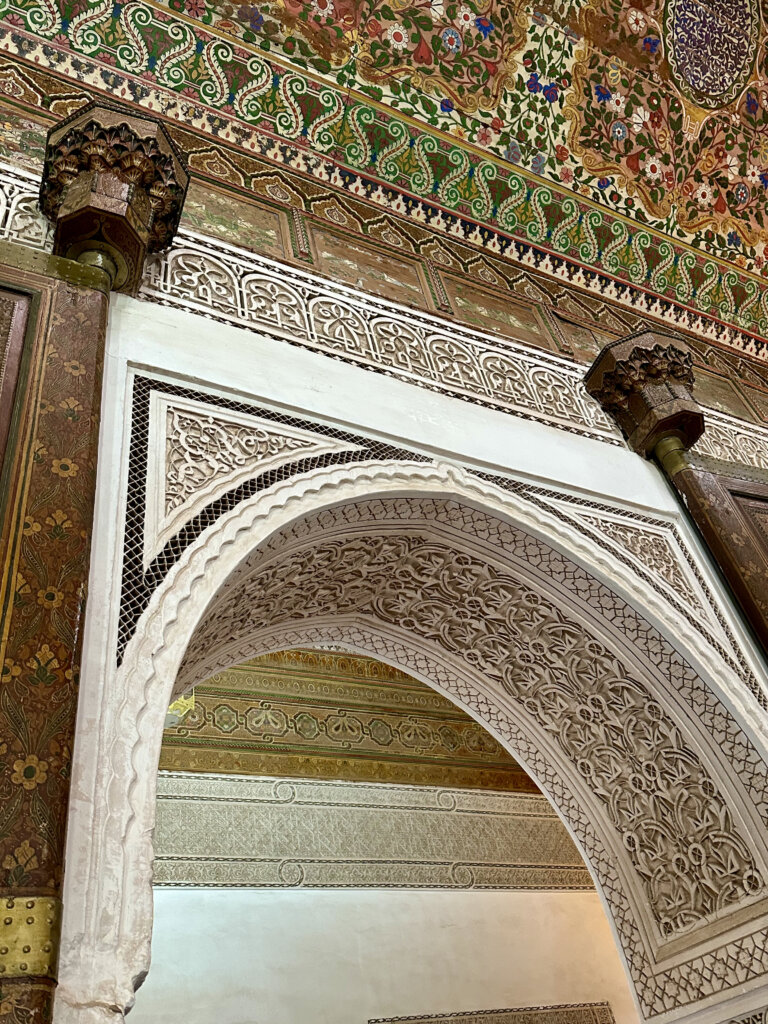
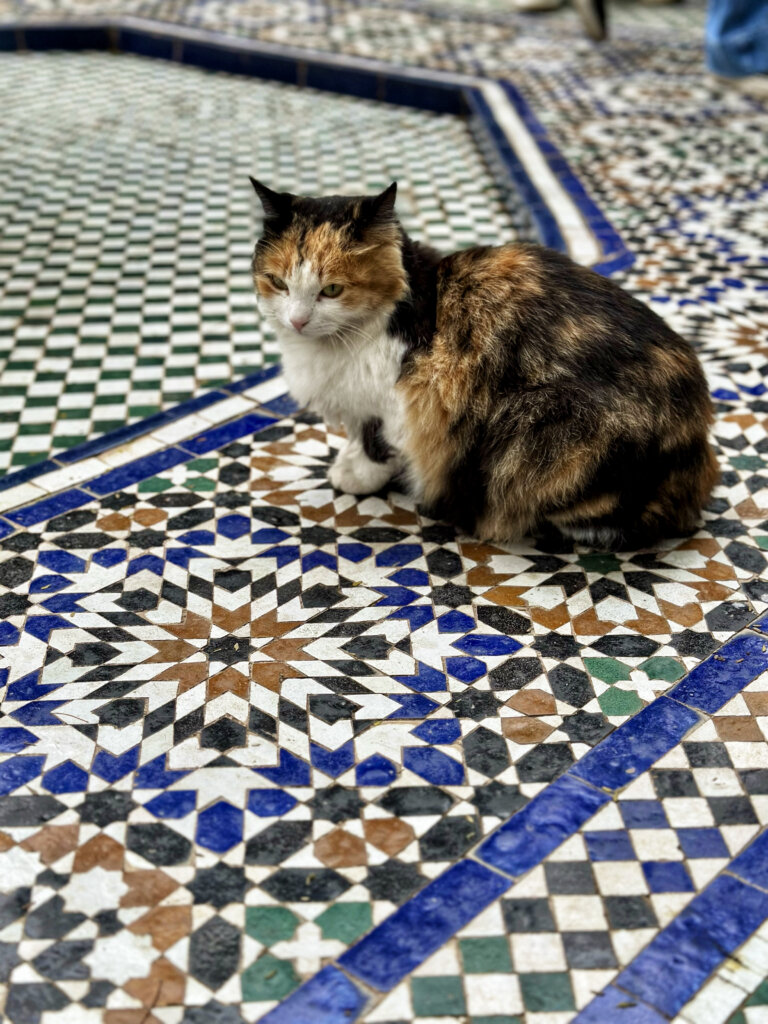
Day 10 Casablanca
As the economic capital of Morocco, Casablanca is less interesting than other places on this itinerary so I wouldn’t recommend a lot of your precious vacation time here.
However, you’ve simply got to see the incredible Hassan II Mosque, the largest functioning mosque in Africa.
It features s stunning architecture and intricate details both inside and outside and is the main reason we visited Casablanca at all.
Designed by French architect Michel Pinseau, this mosque was built on a promontory overlooking the Atlantic Ocean in 1993 and can accommodate up to 25,000 worshippers at a time.
The mosque’s minaret is the tallest in the world, standing at 689 feet tall!
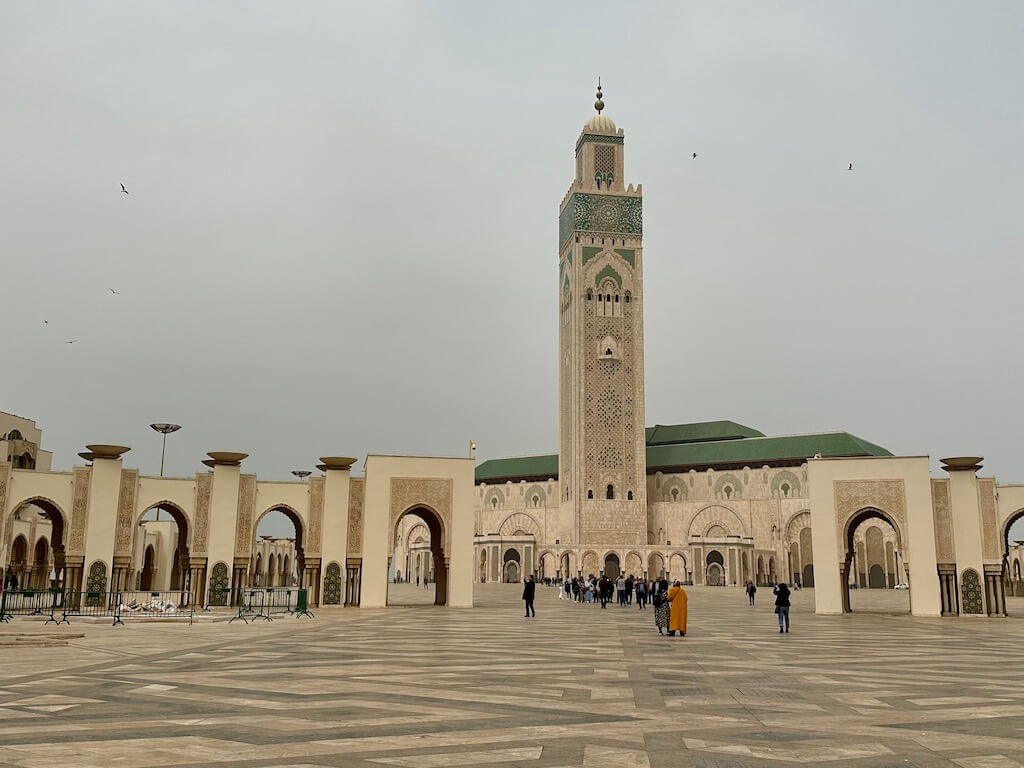
The interior of the mosque is just as impressive, with more incredible tilework, ornate plasterwork, and beautiful chandeliers adorning the main prayer hall.
One of the most unique features of the Hassan II Mosque is the retractable roof, which allows the mosque to be open to the sky during prayer times.
This mosque is also the only functioning mosque that permits visitors who are non-Muslim so don’t miss this experience!
Where to stay in Casablanca: While we didn’t stay in Casablanca ourselves, travelers love Hôtel particulier Le DOGE. Just 10 minutes from the medina, the hotel serves a full breakfast and gets top marks for its creative art deco-themed decor.
Check price and availability at Hôtel particulier Le DOGE here.

Morocco Itinerary 14 Days
With four extra days in Morocco, spend two of them in Marrakech and two days at the coast in Essaouira.
If you’re flying home from Casablanca or Rabat, then add Essaouira to your itinerary after your visit to Marrakech. It’s about a four-hour drive from Essaouira back to Casablanca and a five-hour drive to Rabat.
Here are my suggestions on how to spend these extra days…
Days 11 &12 Day Tours from Marrakech
There’s no better way to explore Moroccan cuisine than with your very own cooking class.
If you have a full extra day in Marrakech after sightseeing, spend half your day at a cooking class and then enjoy your hamam this evening.
I can’t say enough about our experience at Atelier de Cuisine with Chef Tarik. This is an authentic cultural hands-on experience where you’ll learn all about Moroccan cuisine.
You’ll enjoy a traditional tea ceremony, make several tagines over a charcoal fire, tour the organic garden, and eat a delicious multi-course meal at the end.
Plus, by choosing this cooking class, you’re supporting local women from the village enrolled in the chef’s credentialing program for up-and-coming chefs. Atelier de Cuisine is located about 30 minutes from Marrakech out in the countryside.
It’s a truly magical day!

Day 13 &14: Essaouira
Essaouira is a charming seaside town that is known for its relaxed atmosphere and beautiful beaches. Personally, I’d love to base here for a week or so on a return visit!
It’s about a three-hour drive from Marrakech so take a leisurely morning and then head out.
There are two things travelers typically do on this route and they both involve Morocco’s famous argan oil.
The first is to stop to see the goats in the argan trees.
These adorable goats literally stand up in the trees munching argan fruits and dispersing seeds in their feces which increases the number of argan trees. It’s quite a sight to behold.
However, after a reader on my Facebook page pointed this out as animal cruelty—having watched a goat fall from a tree herself—I researched a bit deeper and I’d have to agree.
Training the goats to stand in the trees, eerily still, for many hours in a day, leads to dehydrated goats that sometimes fall 12 feet or more.
What began as an enterprising way for locals to earn a little extra money in tips from tourists (to feed their goat herds, in fact) has now mushroomed into a bigger enterprise that I can’t really support.
You can read more in this article in National Geographic magazine (but will need to sign up for a free account to get past the paywall).
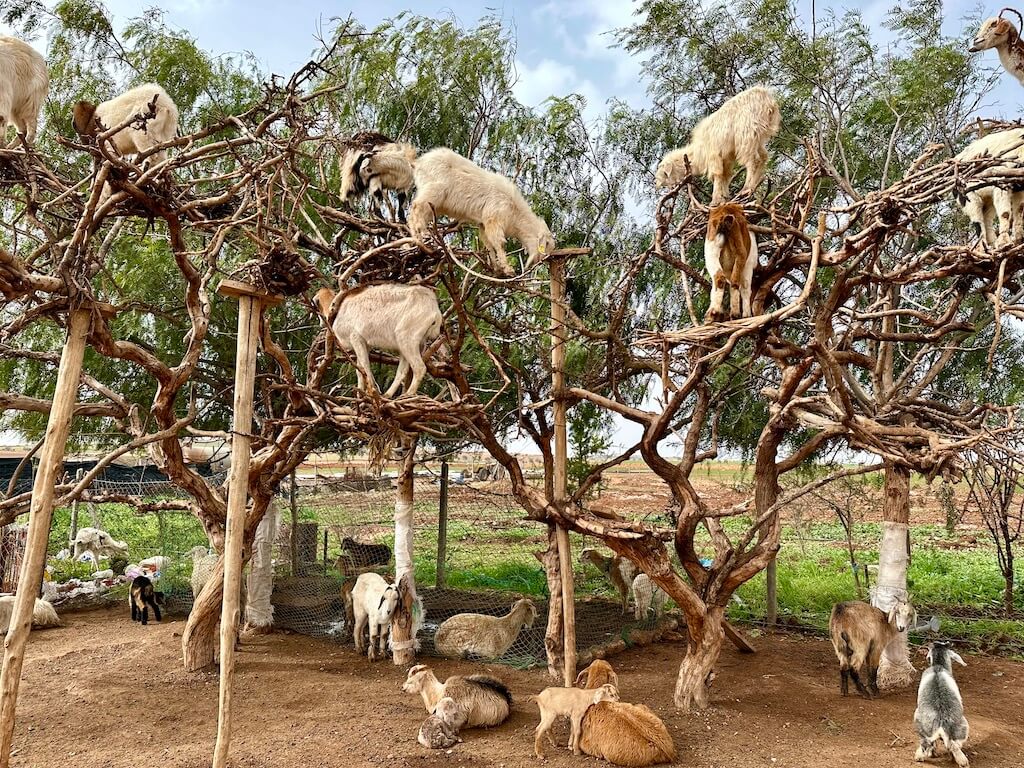
On a happier note, I wholeheartedly recommend that you stop in at the ladies’ argan cooperative, also on the road to Essaouira.
It’s a great example of a business making really excellent products while lifting women out of poverty.
You’ll enjoy a brief look at how the women crack open and process the argan nuts and then have an opportunity to visit the store where I challenge you not to buy all the things!
Seriously, the selection of cosmetics, oils, and other argan products is really incredible.
This is a great place to buy a gift or souvenir and know that your tourist dollar is going to just the right place!
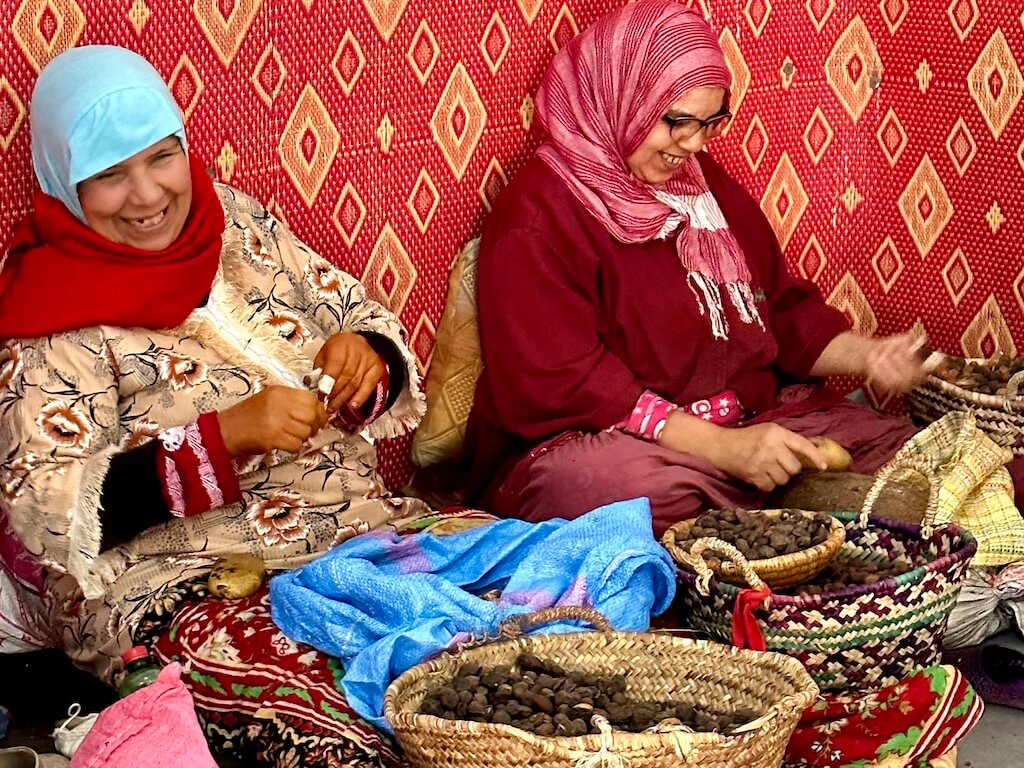
Spend your second day in Essaouira exploring the town’s narrow streets, visiting the local markets, and enjoying fresh seafood by the sea.
Essaouira (pronounced “Ess-WEER-uh”), known by the name of Mogador until the 1960s, was a historic Roman trading post in the 5th century BC.
Be sure to head over to the scenic harbor where you’ll find lots of bright blue wooden fishing boats.
This blue is known as “Tyrian purple” and was a rare and expensive pigment sought in ancient times.
Also visit Skala de la Ville, an 18th-century fortress that offers stunning views of the harbor and the Atlantic Ocean.
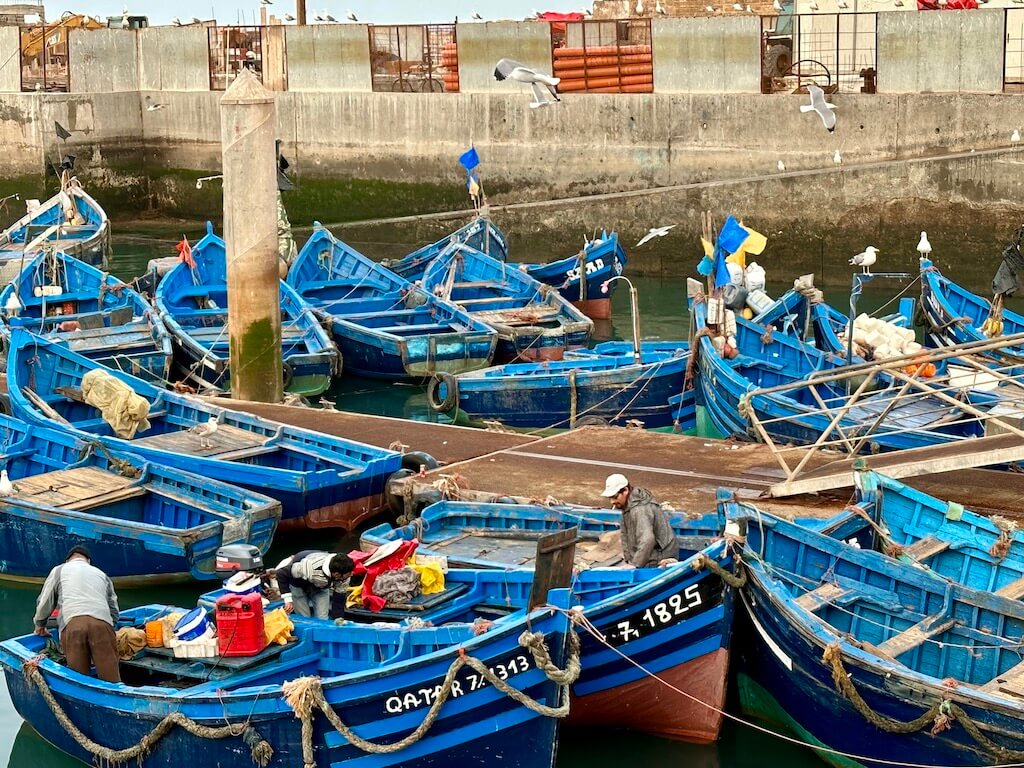
Where to stay in Essaouira: Essaoiura can be tough as it’s a popular party town so can be loud at night.
We stayed on the outskirts of the town to minimize noise. Even still, we had a room above the bar and ended up complaining about the late-night noise.
I’d book instead at Dar Liouba riad which is in the quietest part of the medina. Travelers rave about the delicious breakfast, quiet location, and well-appointed rooms here.
Check price and availability at Dar Liouba riad here.
Your Morocco itinerary is a wrap.
Whether you’re spending 10 days in Morocco or two weeks, the perfect Morocco itinerary is a mix of UNESCO World Heritage sites, vibrant imperial cities, artisan appreciation, and unique nature experiences.
Morocco is a photographer’s dream. And you won’t find a warmer welcome anywhere. Enjoy!
Morocco FAQ
1. How many days do you need in Morocco?
The number of days you need in Morocco depends on where you want to visit and the experiences you want to have. Visit for seven to 10 days to explore imperial cities like Marrakech and Fez and the Sahara Desert. If you have three to five days, spend it in Marrakech with a possible trip to the Sahara Desert.
2. Is Casablanca better than Marrakech?
No. Casablanca is not better. Marrakech is Morocco’s most vibrant and cosmopolitan city. Casablanca is Morocco’s economic engine. The main attraction there is Hassan II mosque, which is definitely worth visiting.
3. What are the best months to visit Morocco?
The best months to visit Morocco are from March to May and September to November, as the weather is mild and pleasant. Peak tourist season is from June to August, so expect higher prices and more crowds then. Plus, the Sahara Desert is 120 degrees Fahrenheit then!
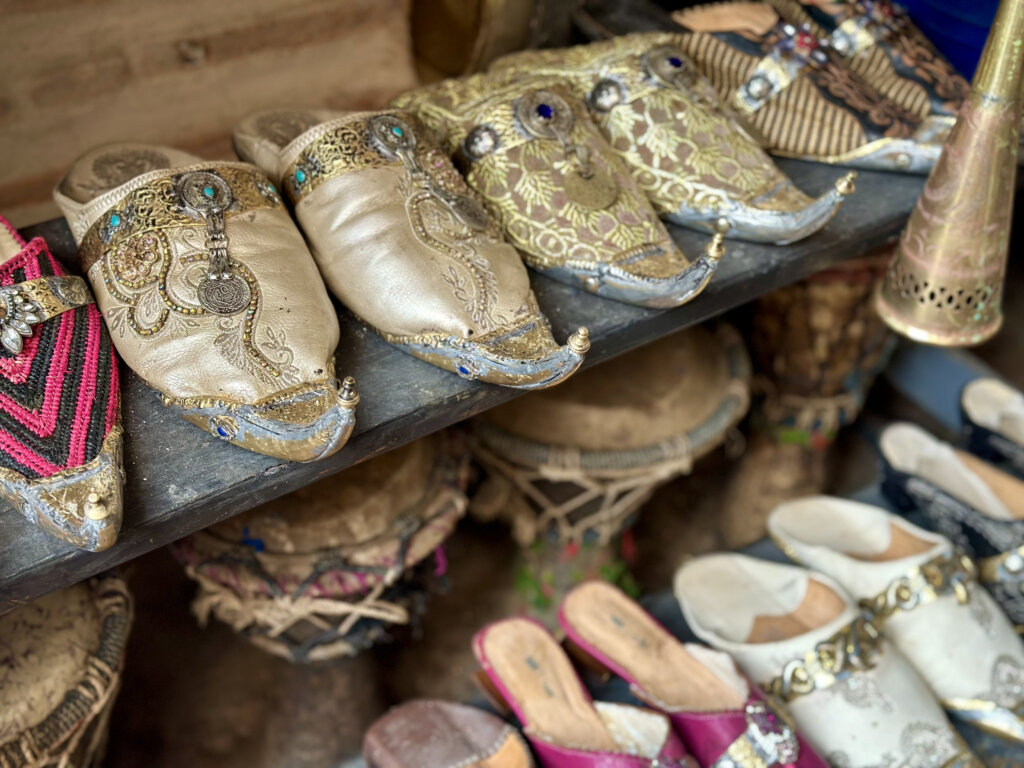
4. Is Morocco an expensive vacation?
Morocco is a budget-friendly destination. It can be surprisingly affordable to stay in five star hotels, eat at high-end restaurants, and engage a private driver and tour guide.
5. What language is spoken in Morocco?
The official languages of Morocco are Arabic and Berber, but French is also widely spoken, particularly in tourist areas.
6. What should I wear when visiting Morocco?
Morocco is a predominantly Muslim country, so it’s advisable to dress more conservatively, particularly in rural areas. Women should cover their arms and legs. However, if it’s warm and you’re at the beach or in a big city, it’s okay to dress in a more relaxed manner. Just cover up if you’re visiting a mosque or you feel out of place.
7. How should I get around Morocco?
It’s possible to rent a car in Morocco. The roads are quite good but it’s extremely common to get traffic tickets and you’ll need to prepare to pay a small bribe when stopped. Agree on a price ahead of time when using a taxi. Hiring a driver is a safe and affordable opion.
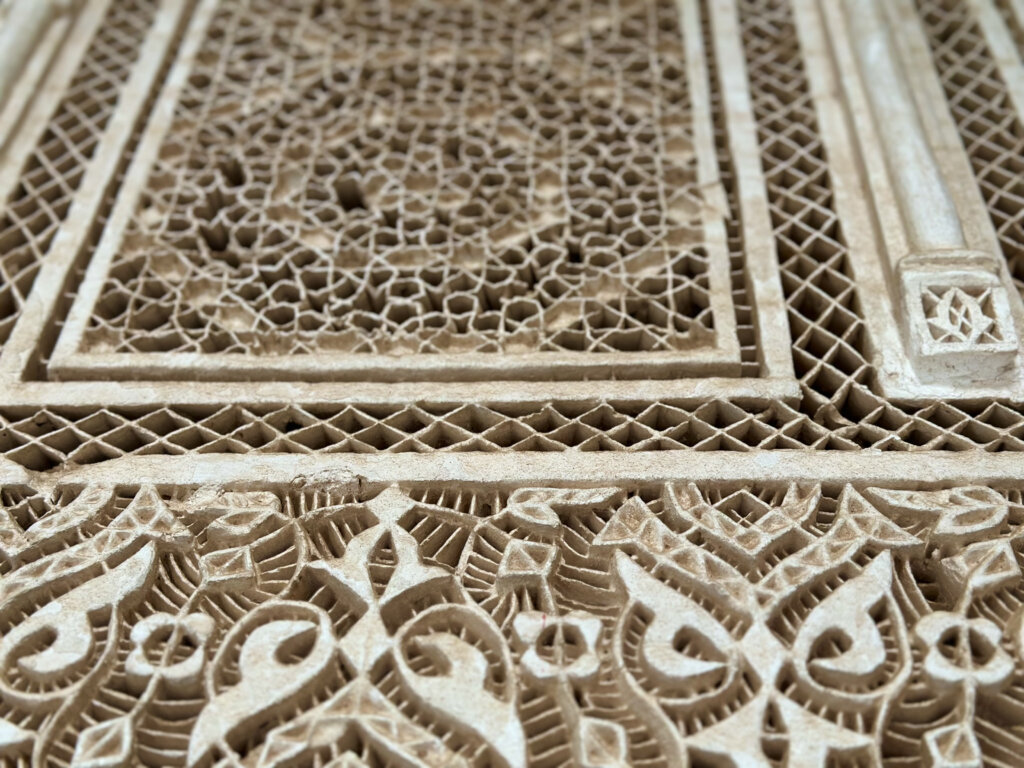
8. What are some must-visit attractions in Morocco?
Some of the must-visit attractions in Morocco include Marrakech, the Sahara Desert, Fez, Chefchaouen, and the Atlas Mountains.
9. What is the cuisine like in Morocco?
Moroccan cuisine is flavorful but not spicy, with influences from Berber, Arab, and European cultures. Popular dishes include tagine, couscous, and harira soup. Sweet mint tea is everywhere. Try the freshly squeezed fruit juices!
10. What is the etiquette for haggling in Moroccan markets?
Haggling is a common practice in Moroccan markets, but it’s important to do so respectfully. Start by sharing your desire to support local artisans with your purchase. Offer a low price and be prepared to negotiate and also walk away if you can’t agree on a price that’s worth it to you.
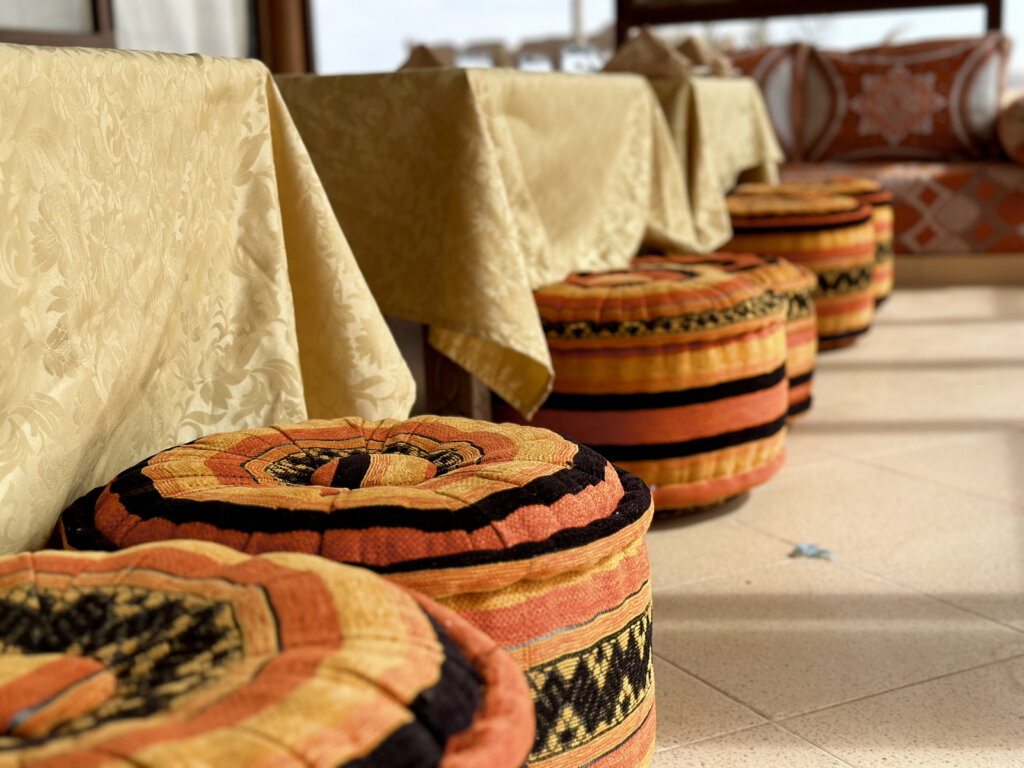
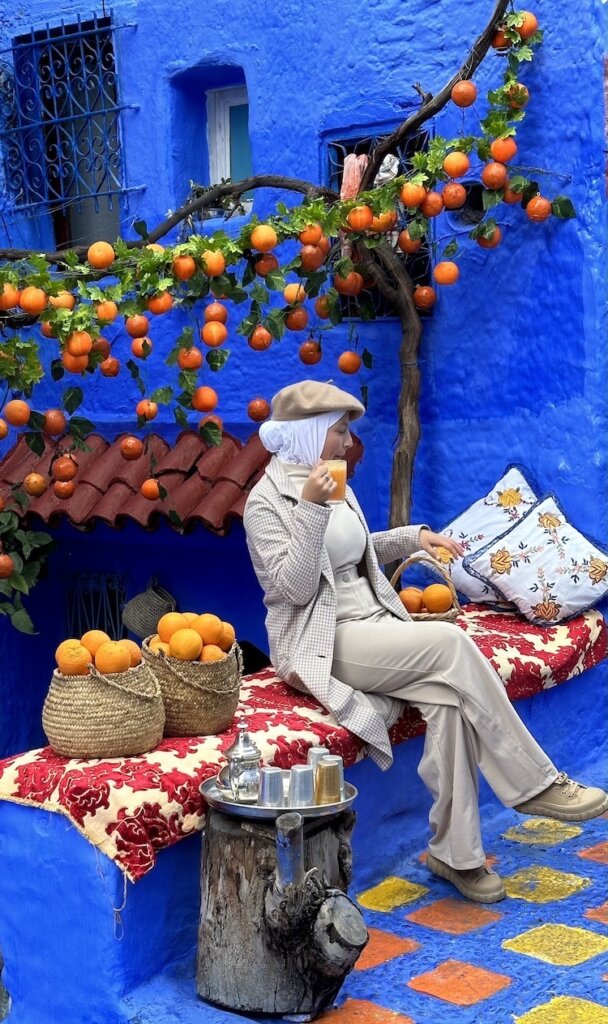
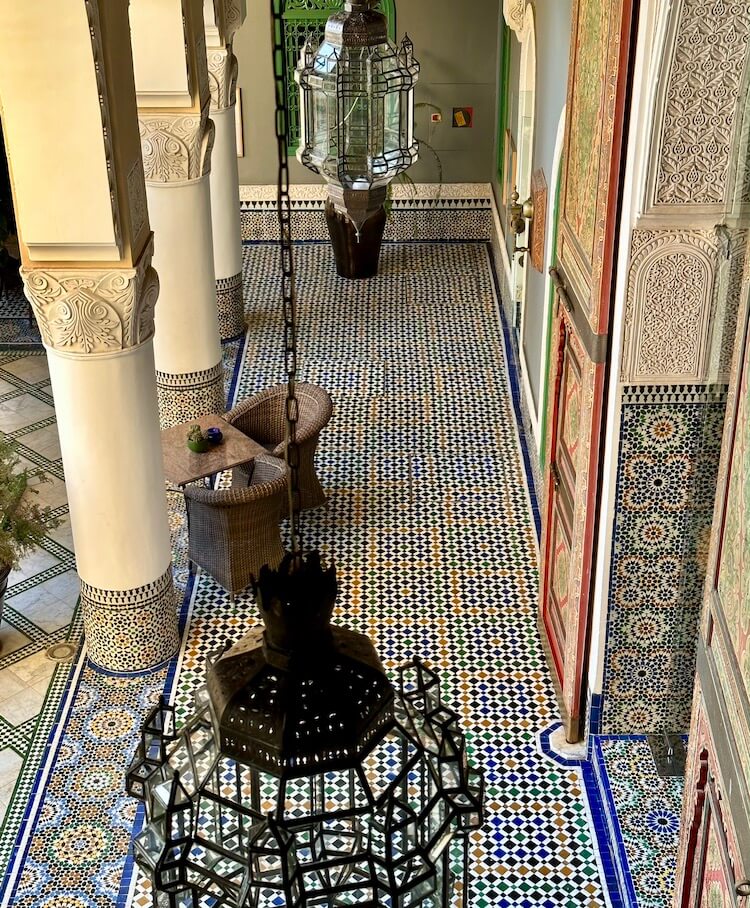
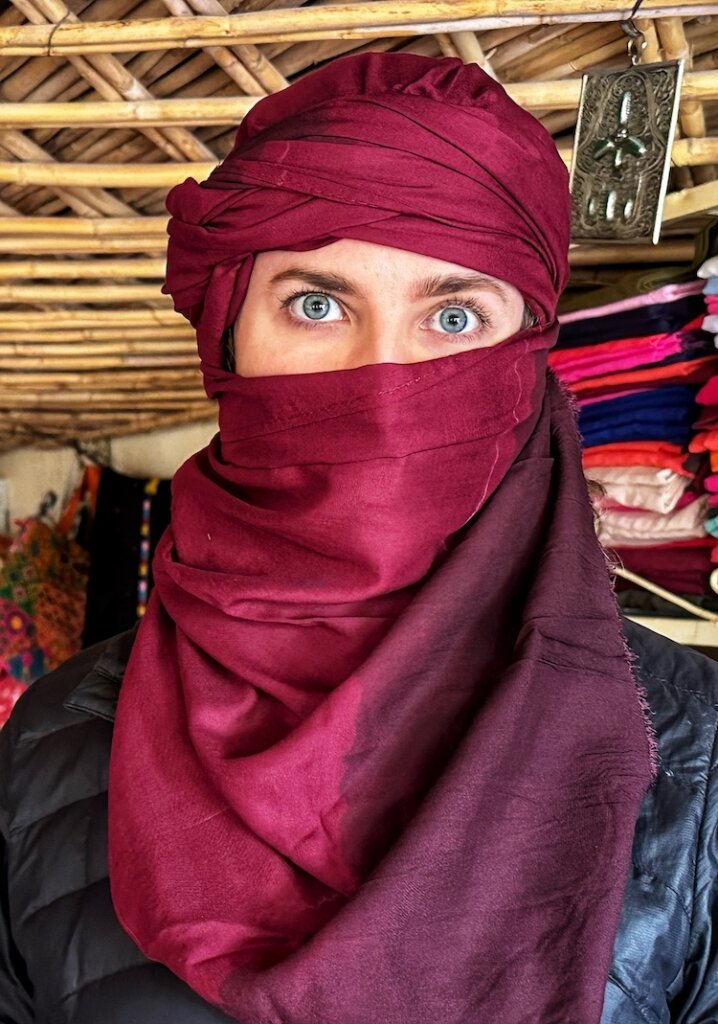
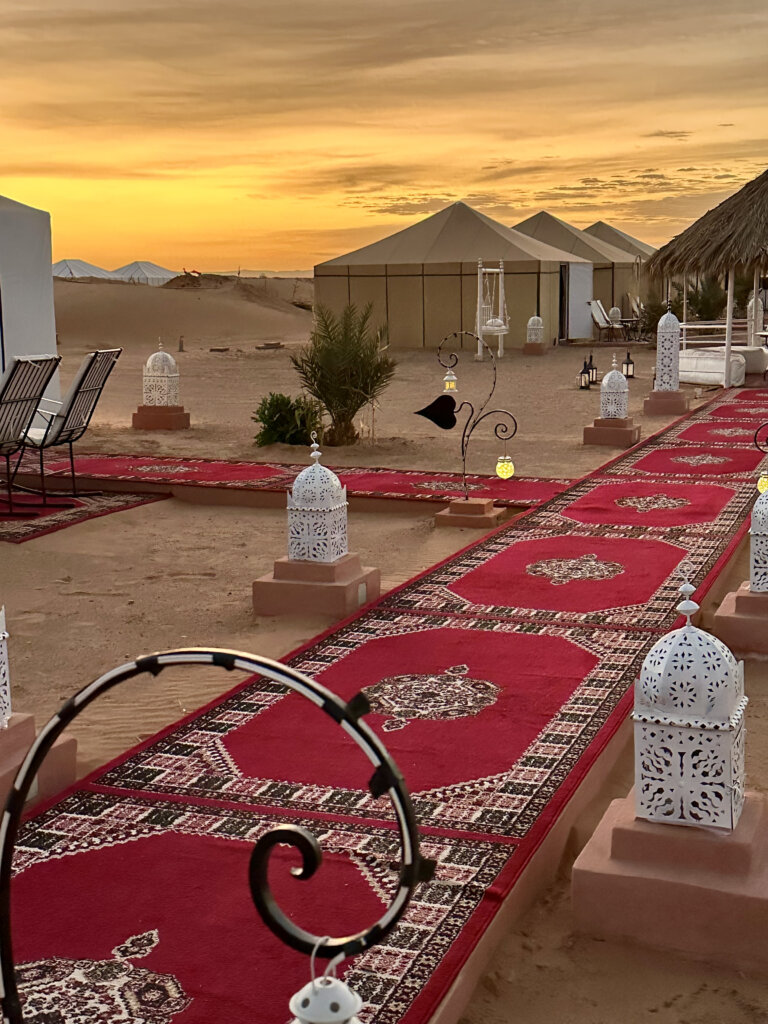
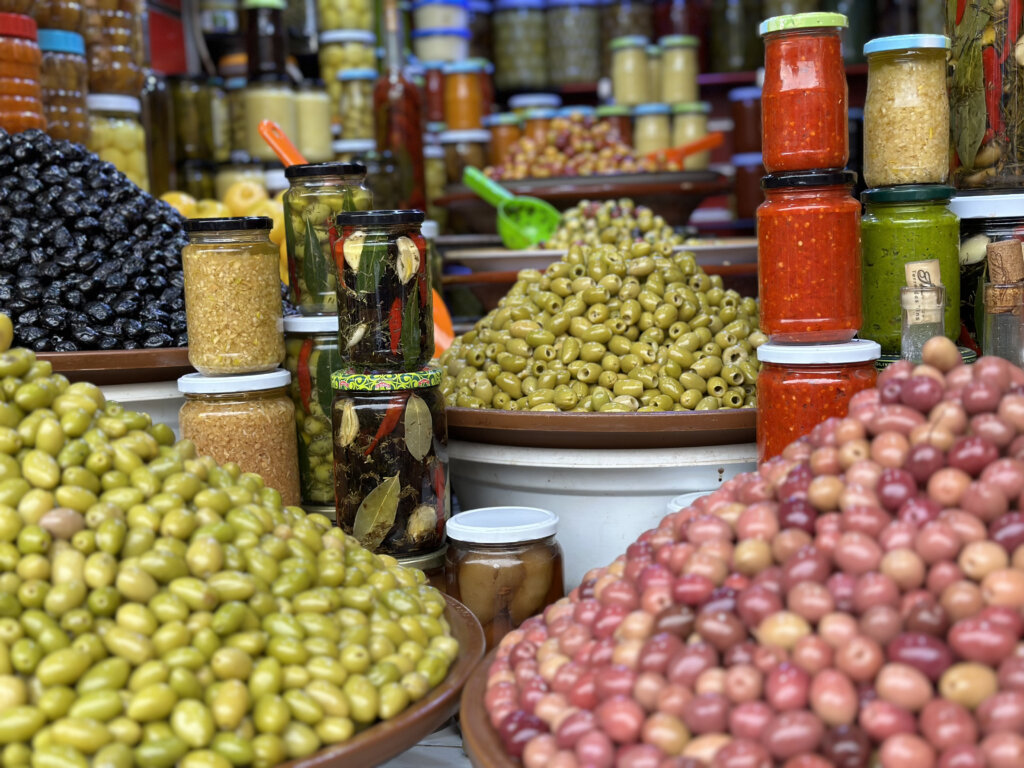
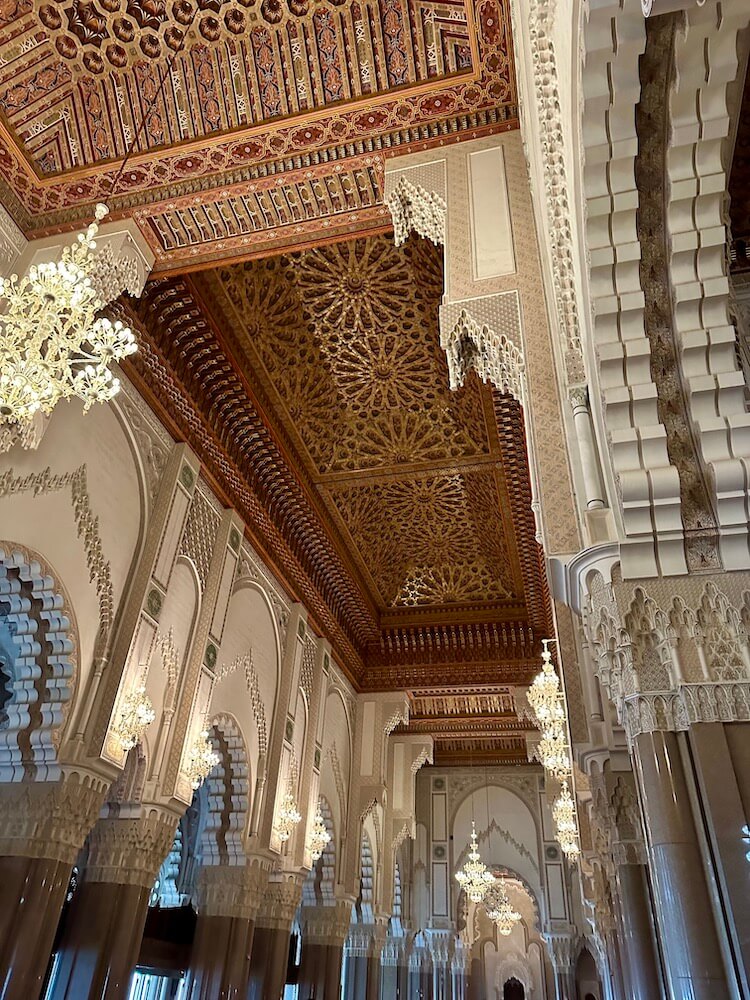
Hi, lovely post! May I know how you paid for the private driver and tour guide? Many of websites I visited don’t have a proper portal to make payment and the quotes I’ve been receiving from guides are asking to transfer the money via PayPal or bank account, which I fear may be a scam. How could you tell whether it’s legit?
Hi Sara, Excellent question. I can only vouch for Said Hatouchi and Morocco Daily Tours in terms of the integrity of tour guides but yes, this wasn’t straight forward. We paid a 15% deposit via PayPal and then the balance upon arrival for our tour. He accepts payment via credit card, cash or PayPal but you are responsible for associated fees (4.5% percent on PayPal although the tour company pays them for the deposit). The problem is that fees can really add up for a long tour. To avoid them, I recommend downloading the Remitly app BUT definitely familiarizing yourself with the finer points and setting it up with your preferred payment before you go to ensure it processes smoothly. If you set up the app with your bank debit card to transfer the balance due, it costs you basically $4 instead of hundreds! This was honestly the only challenging part of the tour because I didn’t fully understand this before we arrived. 1000% percent worth it though!